SPECIAL TOPIC—Physical electronics for brain-inspired computing
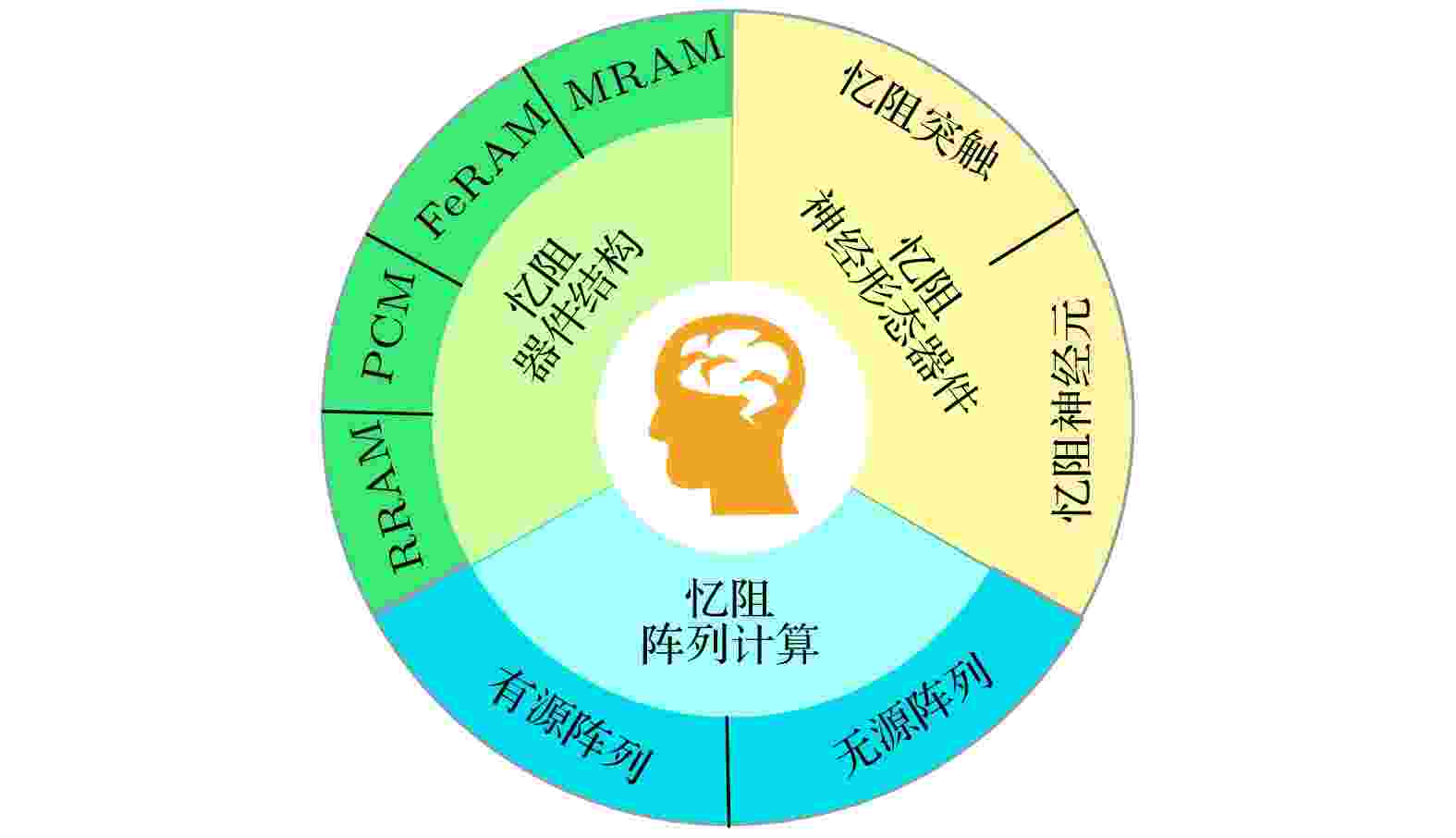
2022, 71 (14): 140501.
doi: 10.7498/aps.71.20220666
Abstract +
With the rapid development of deep learning, the current rapid update and iteration of intelligent algorithms put forward high requirements for hardware computing power. Limited by the exhaustion of Moore’s law and the von Neumann bottleneck, the traditional CMOS integration cannot meet the urgent needs of hardware computing power improvement. The utilization of new device memristors to construct a neuromorphic computing system can realize the integration of storage and computing, and has the characteristics of extremely high parallelism and ultra-low power consumption. In this work, the device structure and physical mechanism of mainstream memristors are reviewed in bottom-to-top order firstly, and their performance characteristics are compared and analyzed. Then, the recent research progress of memristors to realize artificial neurons and artificial synapses is introduced, including the simulation of specific circuit forms and neuromorphic functions. Secondly, in this work, the structural forms of passive and active memristive arrays and their applications in neuromorphic computing, including neural network-based handwritten digits and face recognition, are reviewed. Lastly, the current challenges of memristive brain-like computing from the bottom to the top, are summarized and the future development of this field is also prospected.

2022, 71 (14): 147301.
doi: 10.7498/aps.71.20220308
Abstract +
Biological perception system has the unique advantages of high parallelism, high error tolerance, self-adaptation and low power consumption. Using neuromorphic devices to emulate biological perceptual system can effectively promote the development of brain-computer interfaces, intelligent perception, biological prosthesis and so on. Compared with other neuromorphic devices, multi-terminal neuromorphic transistors can not only realize signal transmission and training learning at the same time, but also carry out nonlinear spatio-temporal integration and collaborative regulation of multi-channel signals. However, the traditional rigid neuromorphic transistor is difficult to achieve bending deformation and close fit with the human body, which limits the application range of neuromorphic devices. Therefore, the research of flexible neuromorphic transistor with good bending characteristics has become the focus of recent research. Firstly, this review introduces the research progress of many kinds of flexible neuromorphic transistors, including device structure, working principle and basic functions. In addition, the application of the flexible neuromorphic transistor in the field of bionic perception is also introduced. Finally, this review also gives a summary and simple prospect of the above research fields.

2022, 71 (14): 148502.
doi: 10.7498/aps.71.20220226
Abstract +
To develop future interactive artificial intelligence system, the construction of high-performance human perception system and processing system is vital. In a traditional perceptual and processing system, sensors, memory and processing units are physically separated because of their different functions and manufacture conditions, which results in frequent shuttling and format transformation of data resulting in long time delay and high energy consumption. Inspired by biological sensory nervous system, one has proposed the concept of in-sensor computing system in which the basic unit integrates sensor, storage and computing functions in the same place. In-sensor computing technology can provide a reliable technical scheme for the area of sensory processing. Artificial memristive synapse capable of sensing light, pressure, chemical substances, etc. is one type of ideal device for the application of in-sensor computing system. In this paper, at the device level, recent progress of sensory memristive synapses applied to in-sensor computing systems are reviewed, including visual, olfactory, auditory, tactile and multimode sensation. This review points out the challenge and prospect from the aspects of device, fabrication, integrated circuit system architecture and algorithms, aiming to provide possible research direction for future development of in-sensor computing system.

2022, 71 (14): 148504.
doi: 10.7498/aps.71.20220463
Abstract +
With the increasing demands for processing images and videos at edge terminals, complementary metal oxide semiconductor (CMOS) hardware systems based on conventional Von Neumann architectures are facing challenges in terms of energy consumption, speed, and footprint. Neuromorphic devices, including resistive random access memory with integrated storage-computation characteristic and optoelectronic resistive random access memory with highly integrated in-sensor computing characteristic, show great potential applications in image processing due to their high similarity to biological neural systems and advantages of high energy efficiency, high integration level, and wide bandwidth. These devices can be used not only to accelerate large numbers of computational tasks in conventional image preprocessing and higher-level image processing algorithms, but also to implement highly efficient biomimetic image processing algorithms. In this paper, we first introduce the state-of-the-art neuromorphic resistive random access memory and optoelectronic neuromorphic resistive random access memory, then review the hardware implementation of and challenges to image processing based on these devices, and finally provide perspectives of their future developments.
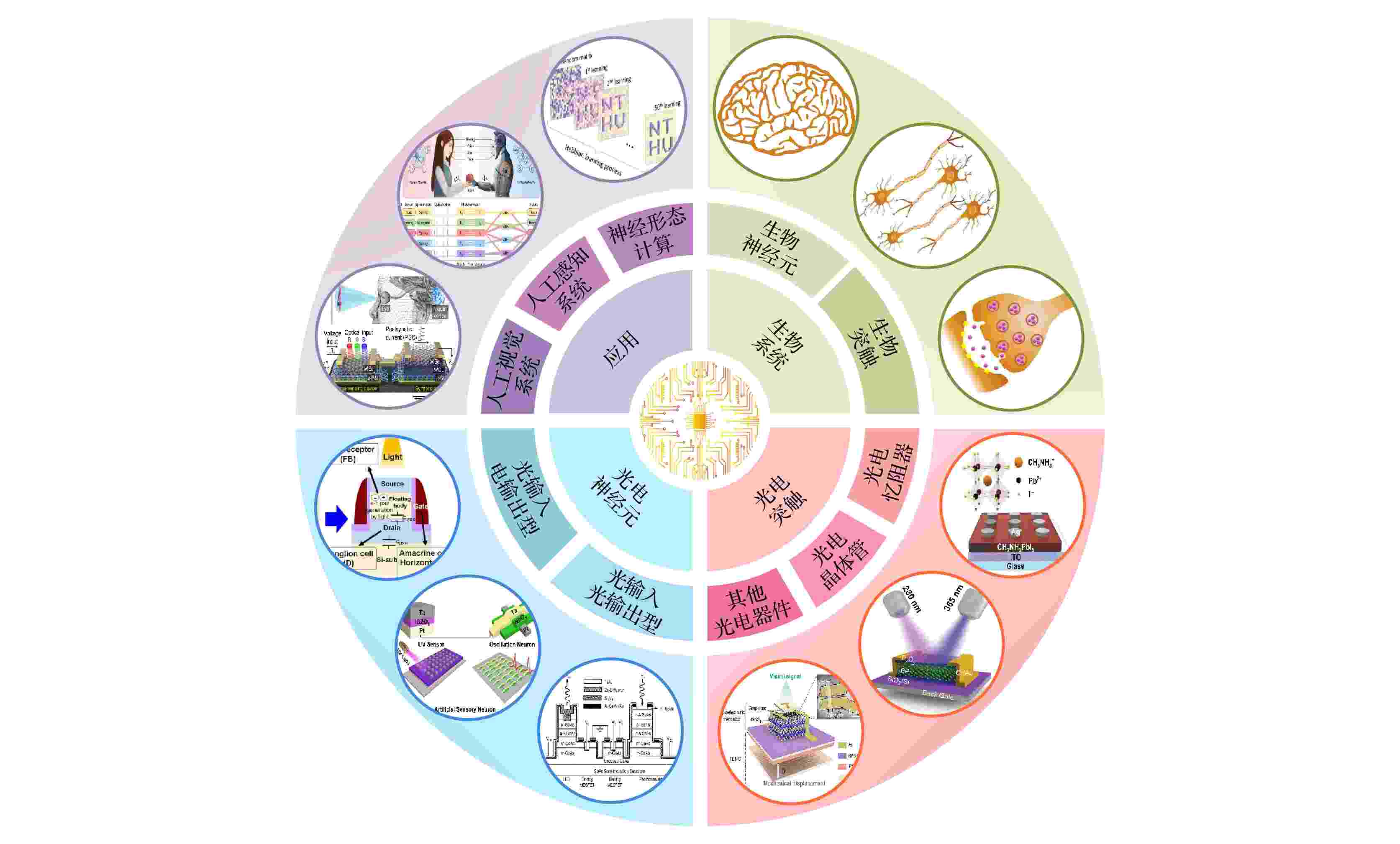
2022, 71 (14): 148505.
doi: 10.7498/aps.71.20220111
Abstract +
Conventional computers based on the von Neumann architecture are inefficient in parallel computing and self-adaptive learning, and therefore cannot meet the rapid development of information technology that needs efficient and high-speed computing. Owing to the unique advantages such as high parallelism and ultralow power consumption, bioinspired neuromorphic computing can have the capability of breaking through the bottlenecks of conventional computers and is now considered as an ideal option to realize the next-generation artificial intelligence. As the hardware carriers that allow the implementing of neuromorphic computing, neuromorphic devices are very critical in building neuromorphic chips. Meanwhile, the development of human visual systems and optogenetics also provides a new insight into how to study neuromorphic devices. The emerging optoelectronic neuromorphic devices feature the unique advantages of photonics and electronics, showing great potential in the neuromorphic computing field and attracting more and more attention of the scientists. In view of these, the main purpose of this review is to disclose the recent research advances in optoelectronic neuromorphic devices and the prospects of their practical applications. We first review the artificial optoelectronic synapses and neurons, including device structural features, working mechanisms, and neuromorphic simulation functions. Then, we introduce the applications of optoelectronic neuromorphic devices particularly suitable for the fields including artificial vision systems, artificial perception systems, and neuromorphic computing. Finally, we summarize the challenges to the optoelectronic neuromorphic devices, which we are facing now, and present some perspectives about their development directions in the future.

2022, 71 (14): 148507.
doi: 10.7498/aps.71.20220397
Abstract +
By integrating the storage and computing functions on the fundamental elements, computing in-memory (CIM) technology is widely considered as a novel computational paradigm that can break the bottleneck of Von Neumann architecture. Nonvolatile memory device is an appropriate hardware implementation approach of CIM, which possess significantly advantages, such as excellent scalability, low consumption, and versatility. In this paper, first we introduce the basic concept of CIM, including the technical background and technical characteristics. Then, we review the traditional and novel nonvolatile memory devices, flash and resistive random access memory (RRAM), used in non-volatile based computing in-memory (nvCIM) system. After that, we explain the operation modes of nvCIM: in-memory analog computing and in-memory digital computing. In addition, the applications of nvCIM are also discussed, including deep learning accelerator, neuromorphic computing, and stateful logic. Finally, we summarize the current research advances in nvCIM and provide an outlook on possible research directions in the future.
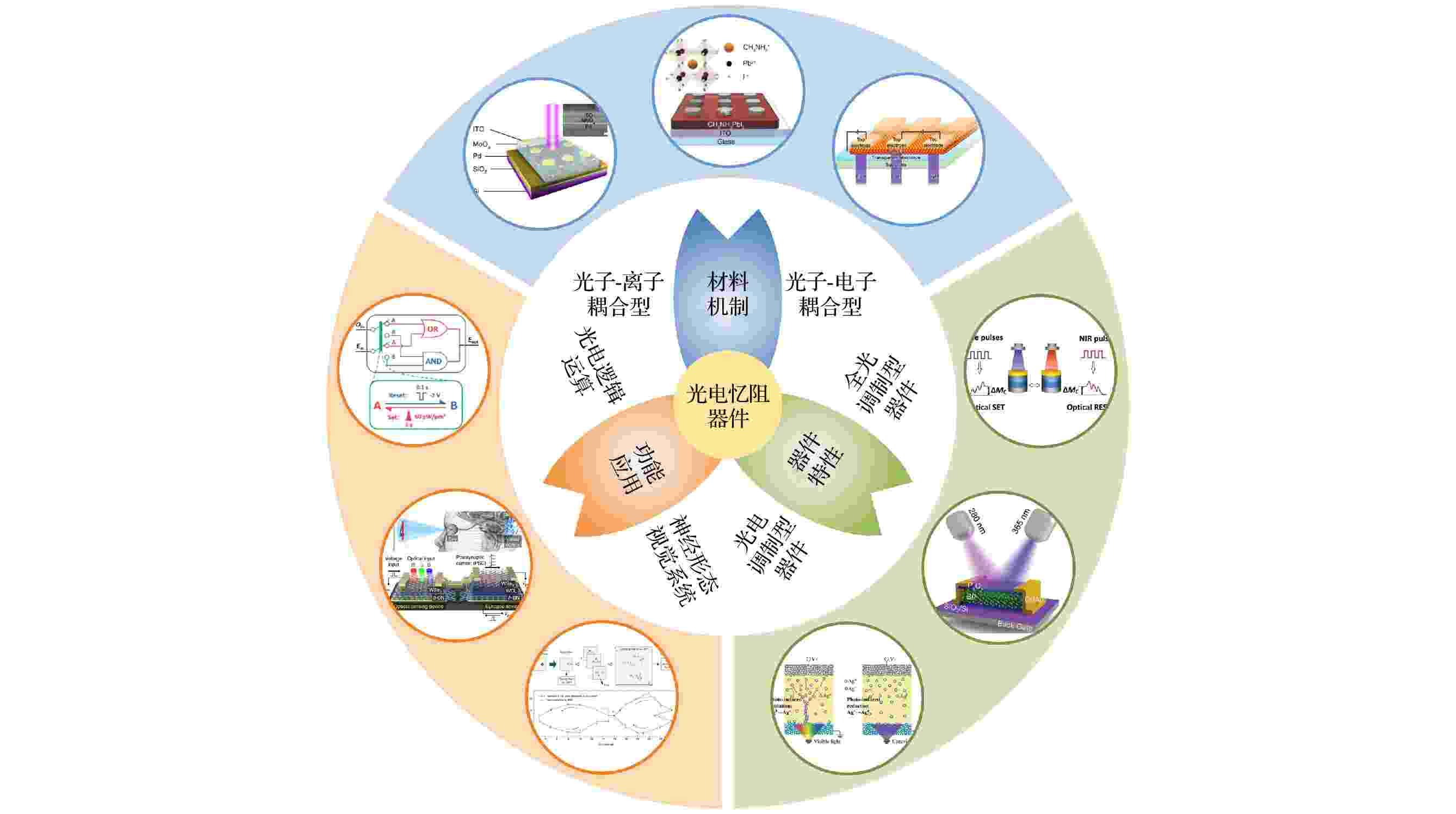
2022, 71 (14): 148701.
doi: 10.7498/aps.71.20220350
Abstract +
Neuromorphic computing system, inspired by human brain, has the capability of breaking through the bottlenecks of conventional von Neumann architecture, which can improve the energy efficiency of data processing. Novel neuromorphic electronic components are the hardware foundation of efficient neuromorphic computation. Optoelectronic memristive device integrates the functions of sensing, memorizing and computing and is considered as a promising hardware candidate for neuromorphic vision. Herein, the recent research progress of optoelectronic memristive device for in-sensor computing are reviewed, including optoelectronic materials and mechanism, optoelectronic memristive device/characteristics as well as functionality and application of in-sensor computing. We first review the optoelectronic materials and corresponding memristive mechanism, including photon-ion coupling and photon-electron coupling type. Then optoelelctronic and all-optical modulated memristive device are introduced according to the modulation mode. Moreover, we exhibit the applications of optoelectronic device in cognitive function simulation, optoelectronic logic operation, neuromorphic vision, object tracking, etc. Finally, we summarize the advantages/challenges of optoelectronic memristor and prospect the future development.
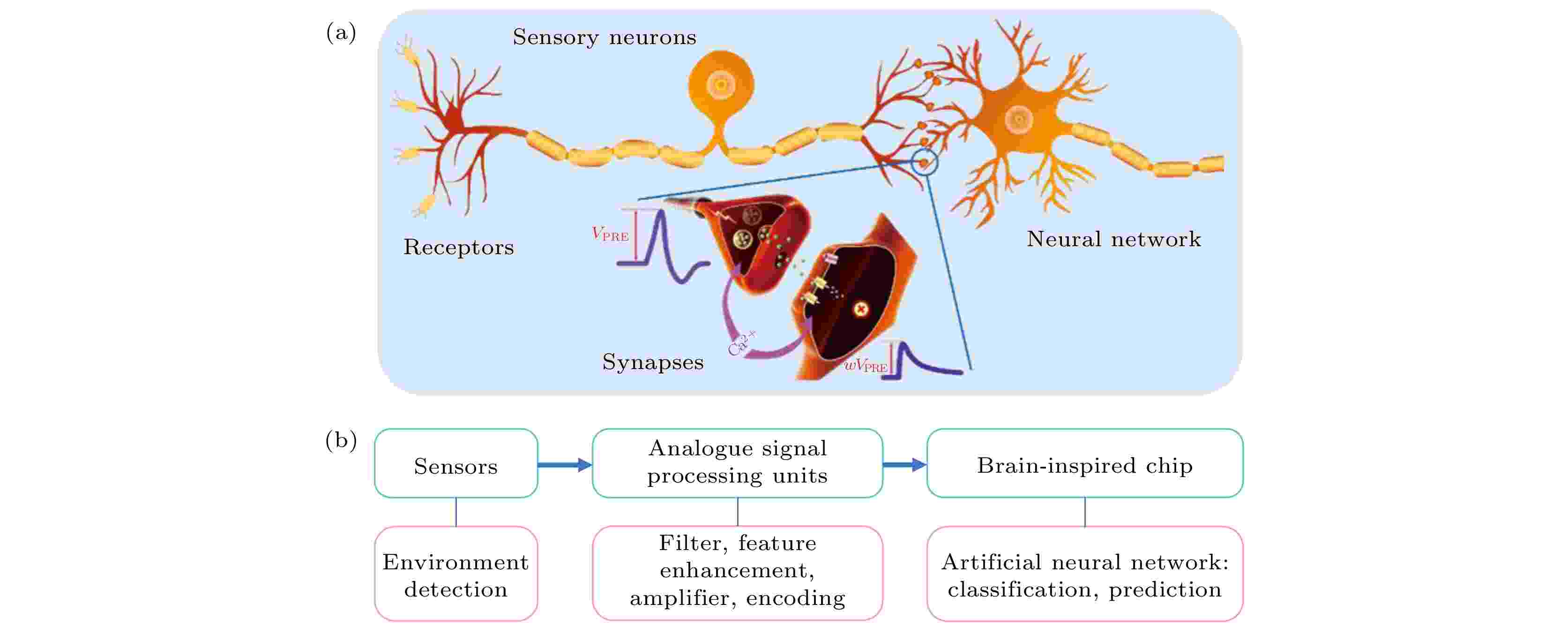
2022, 71 (14): 148702.
doi: 10.7498/aps.71.20220281
Abstract +
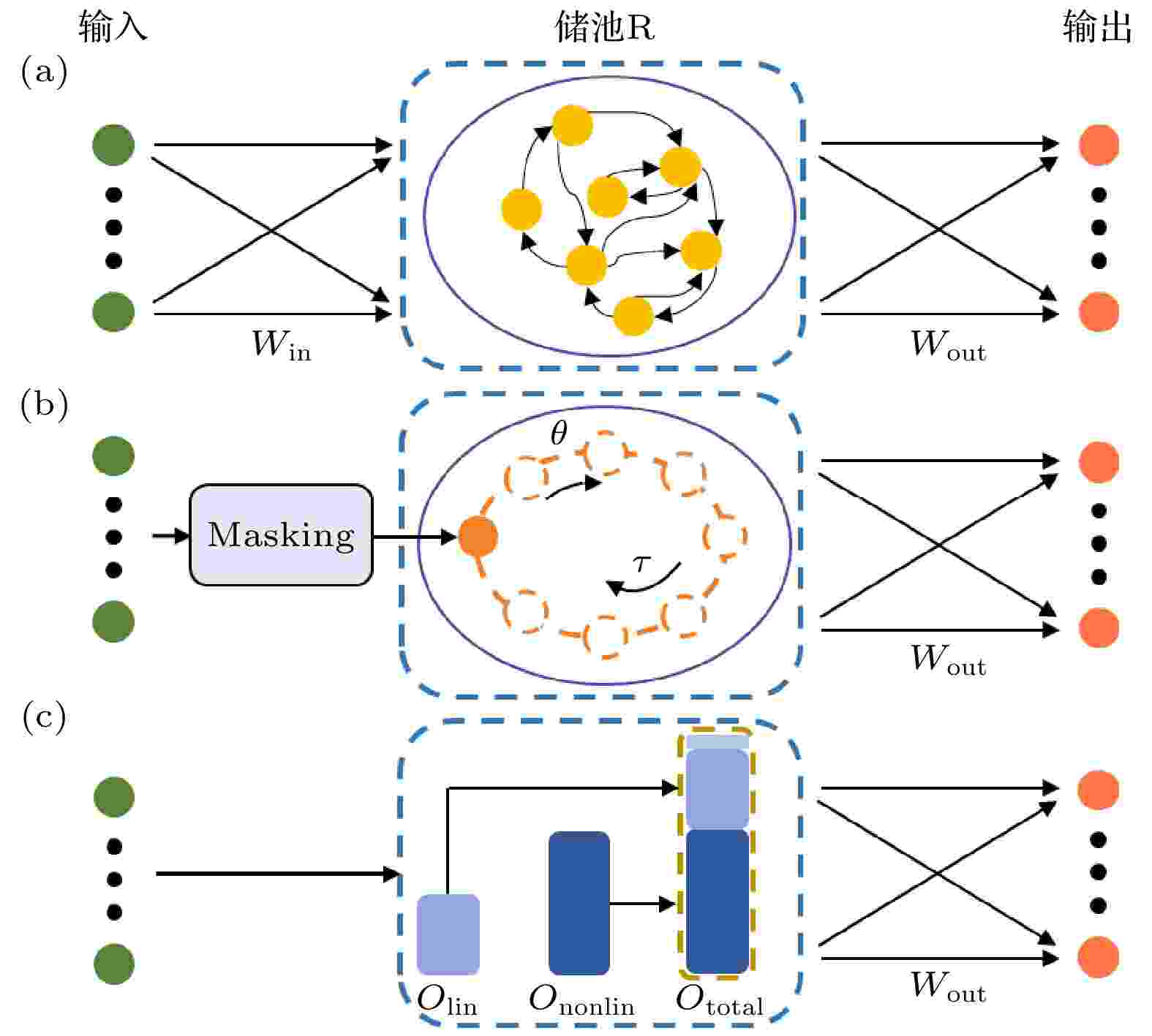
2022, 71 (14): 140701.
doi: 10.7498/aps.71.20220082
Abstract +
As a kind of brain-inspired computing, reservoir computing (RC) has great potential applications in time sequence signal processing and chaotic dynamics system prediction due to its simple structure and few training parameters. Since in the RC randomly initialized network weights are used, it requires abundant data and calculation time for warm-up and parameter optimization. Recent research results show that an RC with linear activation nodes, combined with a feature vector, is mathematically equivalent to a nonlinear vector autoregression (NVAR) machine, which is named next-generation reservoir computing (NGRC). Although the NGRC can effectively alleviate the problems which traditional RC has, it still needs vast computing resources for multiplication operations. In the present work, a hardware implementation method of using computing-in memory paradigm for NGRC is proposed for the first time. We use memristor array to perform the matrix vector multiplication involved in the nonlinear vector autoregressive process for the improvement of the energy efficiency. The Lorenz63 time series prediction task is performed by simulation experiments with the memristor array, demonstrating the feasibility and robustness of this method, and the influence of the weight precision of the memristor devices on the prediction results is discussed. These results provide a promising way of implementing the hardware NGRC.

2022, 71 (14): 148401.
doi: 10.7498/aps.71.20220098
Abstract +
Spiking neural network (SNN) as the third-generation artificial neural network, has higher computational efficiency, lower resource overhead and higher biological rationality. It shows greater potential applications in audio and image processing. With the traditional method, the adder is used to add the membrane potential, which has low efficiency, high resource overhead and low level of integration. In this work, we propose a spiking neural network inference accelerator with higher integration and computational efficiency. Resistive random access memory (RRAM or memristor) is an emerging storage technology, in which resistance varies with voltage. It can be used to build a crossbar architecture to simulate matrix computing, and it has been widely used in processing in memory (PIM), neural network computing, and other fields. In this work, we design a weight storage matrix and peripheral circuit to simulate the leaky integrate and fire (LIF) neuron based on the memristor array. And we propose an SNN hardware inference accelerator, which integrates 24k neurons and 192M synapses with 0.75k memristor. We deploy a three-layer fully connected network on the accelerator and use it to execute the inference task of the MNIST dataset. The result shows that the accelerator can achieve 148.2 frames/s and 96.4% accuracy at a frequency of 50 MHz.
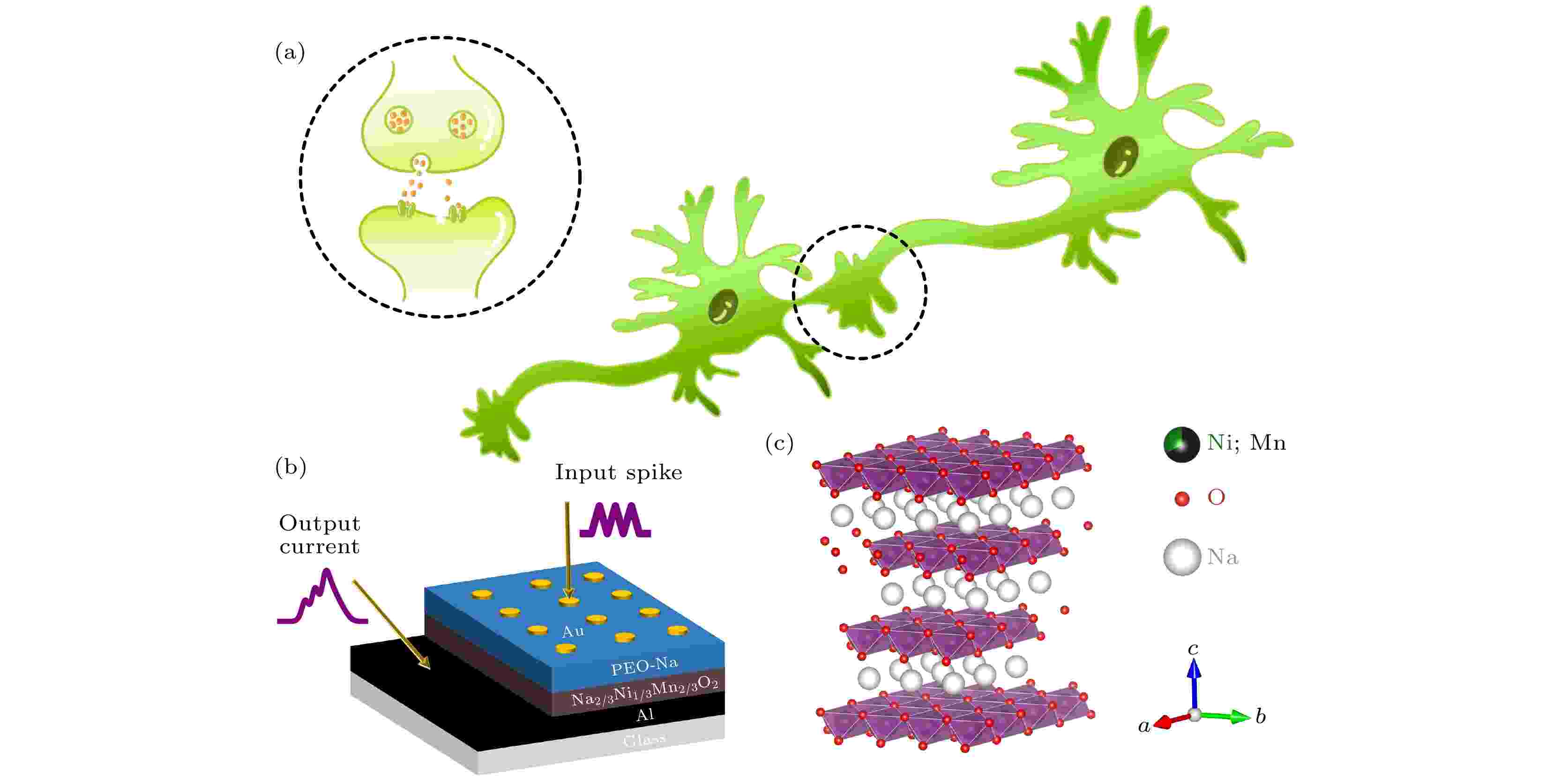
2022, 71 (14): 148501.
doi: 10.7498/aps.71.20220303
Abstract +
Neuromorphic electronics has received considerable attention recent years, and its basic functional units are synaptic electronic devices. A two-terminal artificial synapse with sandwiched structure emulates plasticity of the biological synapses under the action of nerve-like electrical impulse signals. In this paper, P3 phase Na2/3Ni1/3Mn2/3O2 multi-element metal oxides with layered structure are synthesized by sol-gel process. Owing to the fact that Na+ is easy to embed/eject into its crystal structure, an ion-migrating artificial synapse based on Na2/3Ni1/3Mn2/3O2 is designed and fabricated. The device emulates important synaptic plasticity, such as excitatory postsynaptic current, paired-pulse facilitation, spike-number dependent plasticity, spike-frequency dependent plasticity, spike-voltage amplitude dependent plasticity and spike-duration dependent plasticity. The device realizes the identification and response to Morse code commands.

COVER ARTICLE
2022, 71 (14): 148503.
doi: 10.7498/aps.71.20212323
Abstract +
Inspired by the working modes of the human brain, the spiking neuron plays an important role as the basic computing unit of artificial perception systems and neuromorphic computing systems. However, the neuron circuit based on complementary metal-oxide-semiconductor technology has a complex structure, high power consumption, and limited flexibility. These features are not conducive to the large-scale integration and the application of flexible sensing systems compatible with the human body. The flexible memristor prepared in this work shows stable threshold switching characteristics and excellent mechanical bending characteristics with bending radius up to 1.5 mm and bending times up to 104. The compact neuron circuit based on this device shows the key features of the neuron, such as threshold-driven spiking, all-or-nothing, refractory period, and strength-modulated frequency response. The frequency-input voltage relationship of the neuron shows the similarity of the rectified linear unit, which can be used to simulate the function of rectified linear unit in spiking neural networks. In addition, based on the electron transport mechanism, a core-shell model is introduced to analyze the working mechanism of the flexible memristor and explain the output characteristics of the neuron. In this model, the shell region consisting of Nb2O5–x is subjected to ohmic conduction, while the core region consisting of NbO2 is dominated by Poole-Frenkel conduction. These two mechanisms, combined with Newton’s law of cooling, dominate the threshold switching behavior of flexible memristor device. Furthermore, the threshold switching characteristic of the memristor is simulated, verifying the rationality of the working mechanism of the flexible memristor. Considering the fact that the threshold voltage decreases with temperature increasing, a correction term is added to the temperature of the shell region. Subsequently, the output characteristics of the neuron regulated by the input voltage are simulated. The simulation results show that the frequency increases but the threshold voltage decreases with the input voltage increasing, which is consistent with the experimental result. The introduction of the correction term confirms the influence of the thermal accumulation effect of the flexible substrate on neuron output characteristics. Finally, we build a spiking neural network based on memristive spiking neurons to implement handwriting recognition, achieving a 95.6% recognition rate, which is comparable to the ideal result of the artificial neural network (96%). This result shows the potential application of the memristive spiking neurons in neuromorphic computing. In this paper, the study of flexible neurons can guide the design of neuromorphic sensing and computing systems.
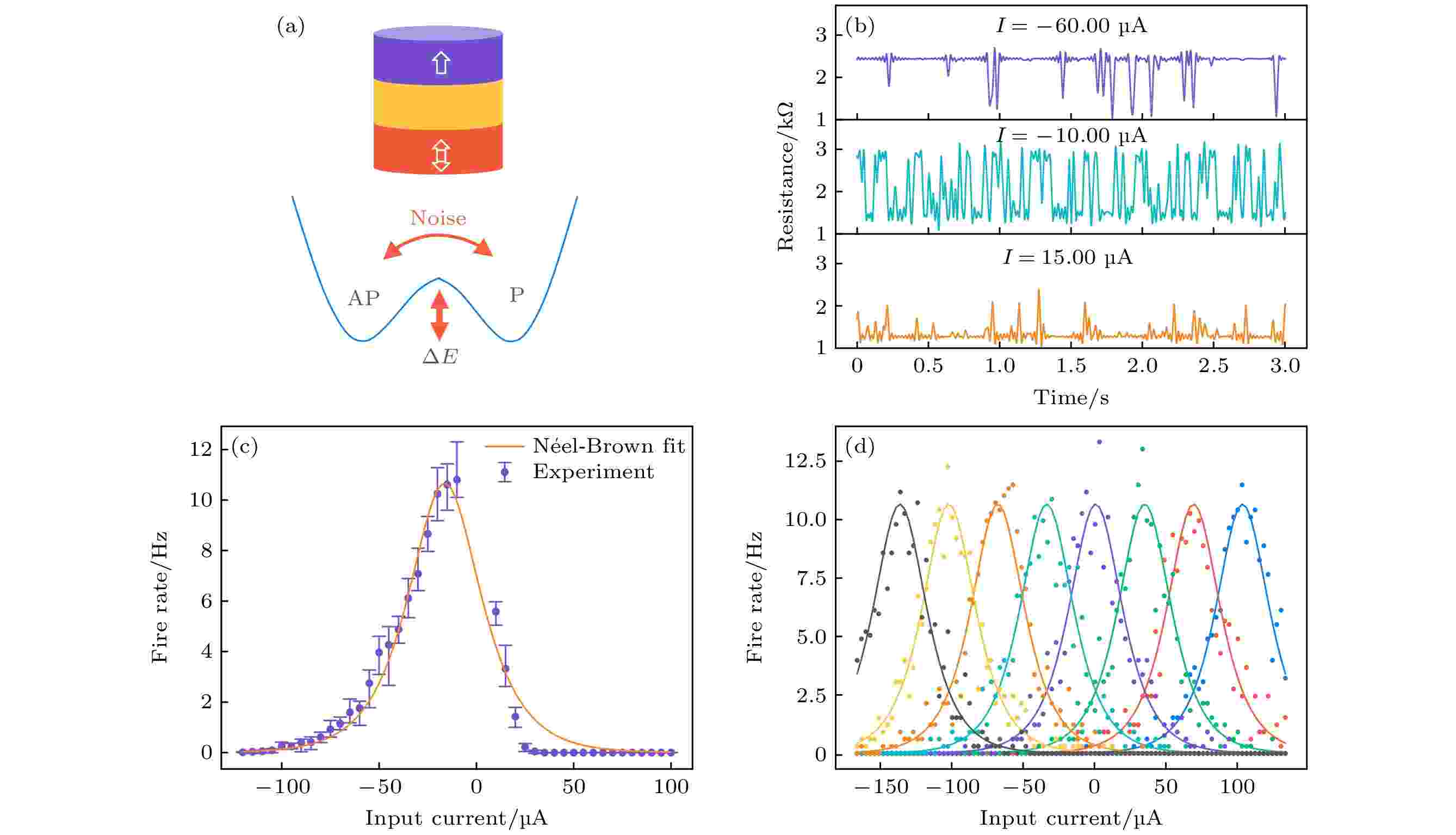
2022, 71 (14): 148506.
doi: 10.7498/aps.71.20220252
Abstract +
Developing suitable algorithms that utilize the natural advantages of the corresponding devices is a key issue in the hardware research of brain-inspired computing. Population coding is one of the computational schemes in biological neural systems and it contains the mechanisms for noise reduction, short-term memory and implementation of complex nonlinear functions. Here we show the controllable stochastic dynamical behaviors for the technically mature spintronic device, magnetic tunnel junctions, which can be used as the basis of population coding. As an example, we construct a two-layer spiking neural network, in which groups of magnetic tunnel junctions are used to code input data. After unsupervised learning, this spiking neural network successfully classifies the iris data set. Numerical simulation demonstrates that the population coding is robust enough against the nonuniform dispersion in devices, which is inevitable in fabrication and integration of hardware devices.
GENERAL

2022, 71 (14): 140201.
doi: 10.7498/aps.71.20212420
Abstract +
According to the generalized Huygens-Fresnel principle, we derive the analytical formula for the complex degree of coherence of the echo light field under the von Karman atmospheric turbulence spectrum condition. Based on split-step beam propagation method of the turbulent phase screen and the target surface model, the fold pass propagation simulation of the laser in the turbulent atmosphere is realized. The dynamic speckle characteristics on the image plane are consistent with the experimental phenomenon. Firstly, the simulation results of the complex degree of coherence and phase structure function of the mirrored reflection echo light field are compared with the theoretical values, which verifies the correctness of the algorithm. Based on this, the complex degree of coherence of the echo light field reflected by the optical rough surface is calculated and analyzed. The results show that on a double-path turbulent flow path of 1.1 km, in other words, it transmits 2.2 km in unfolded mode, the spatial coherence of the echo light field is very sensitive to the root mean square value of height. When the root-mean-square value of height is close to the wavelength, the coherence is seriously degraded. When the correlation length of the target surface is much larger than the atmospheric coherence length, the coherence length of the echo light field is relatively close to the set spatial coherence length. When the correlation length of the target surface is close to the atmospheric coherence length, the influence of the rough surface of the target on the beam coherence cannot be ignored. When the correlation length of the target surface is much smaller than the atmospheric coherence length, the target surface characteristics have a dominant influence on the echo coherence, the spatial coherence of the light field is seriously degraded, and the echo is close to incoherent light. Considering the smooth target reflection surface, the greater the strength of turbulence, the faster the complex coherence decreases with space. The atmospheric coherence diameter ${r_0}$ can be calculated further according to the complex degree of coherence. For the Pearson correlation coefficient the simulation value and theoretical value are both 0.998, which indicates that the atmospheric coherence diameter calculated by the complex degree of coherence has a high correlation with the theoretical value. This research provides a theoretical basis for the coherent detection scheme of echoes from rough surfaces in the turbulent atmosphere. The simulation algorithm extracts the target surface features by analyzing the variation of the complex coherence of laser echo signals in the turbulent atmosphere with the spatial distance, and also provides a method of using the known target surface to obtain path turbulence information.
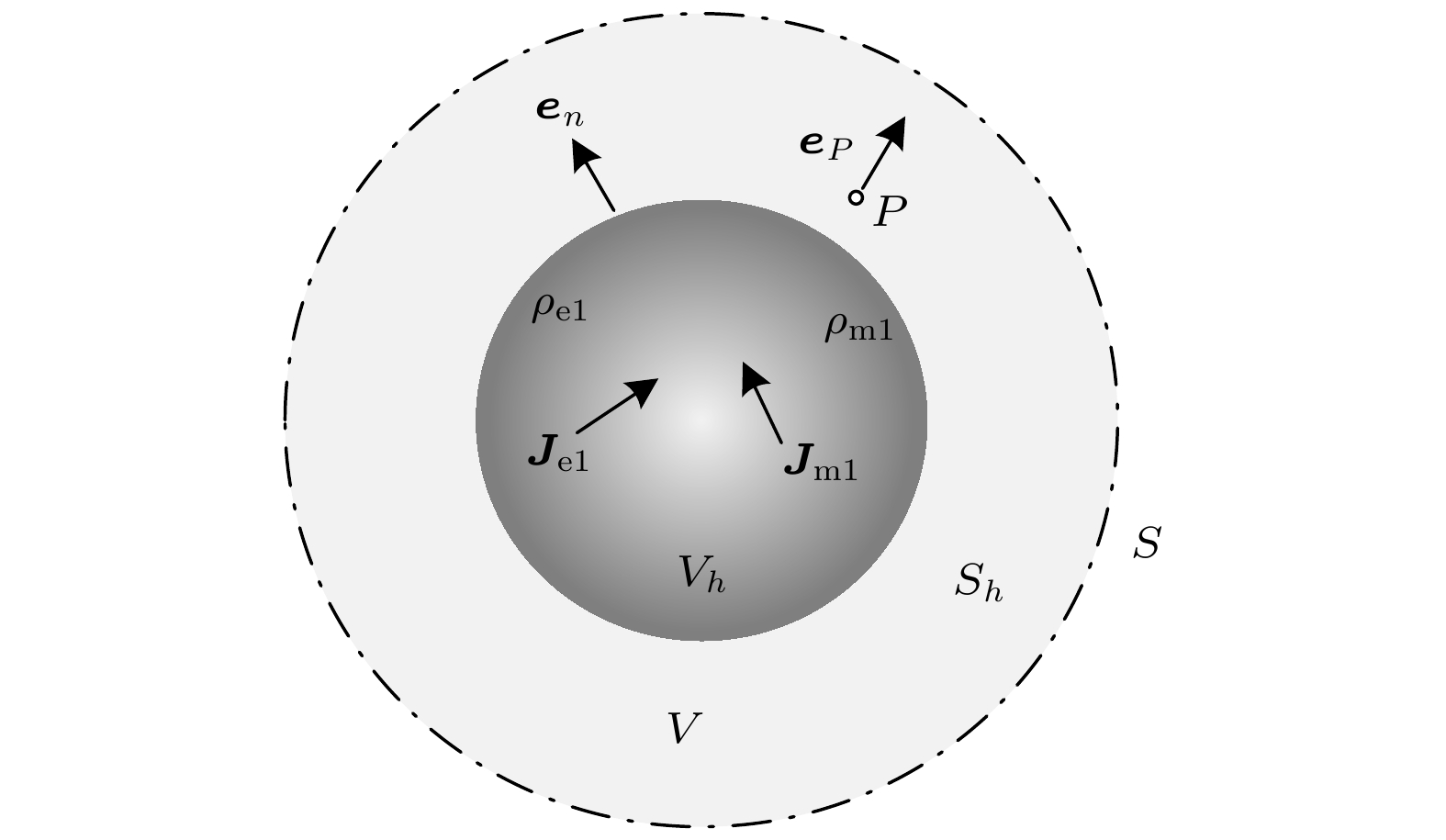
2022, 71 (14): 140301.
doi: 10.7498/aps.71.20212334
Abstract +
The classical reciprocity theorem of electromagnetic field proposed by Lorentz H.A. in 1896 is one of the important theories of electromagnetics. The Lorentz reciprocity theorem is widely used in many fields such as communication, antenna signal transmission, and electromagnetic imaging. The Lorentz reciprocity theorem is an “energy-based” reciprocity theorem. Over the past hundred years, some new reciprocity theorems of electromagnetic field have been discovered, including reciprocity theorems in frequency domain and time domain. In 2020, Lindell et al. extended the concept of the 'Rumsey reaction' in a differential form to include both the Lorentz force density reaction term and the power density reaction term. In the same year, Liu et al. derived the momentum reciprocity theorem from the Maxwell's equations. The momentum reciprocity theorem, like the Lorentz reciprocity theorem, can be used for both theoretical analysis and practical applications. Huygens’ principle is usually derived by the Lorentz reciprocity theorem. In this paper, the momentum reciprocity theorem is employed to derive the Huygens’ principle.

2022, 71 (14): 140702.
doi: 10.7498/aps.71.20220053
Abstract +
Pressure engineering is known as an efficient, continuous and reversible technique capable of tuning material structure, as well as its electrical, optical, and other physical properties. Raman spectroscopy is used to perform efficient and non-destructive analysis of material structure, and is compatible with the application of external tuning fields. In this work, we combine in-situ pressure engineering and polarized Raman spectroscopy to study the pressure-induced evolution of 18 Raman-active modes in ReS2 crystal. We find that the ReS2 undergoes a structural transformation from 1T' to a distorted-1T' phase at 3.04 GPa, followed by an intralayer deformation of Re4 clusters occurring at 14.24 GPa. Interlayer transitions from disordered to ordered stacking in different in-plane directions are observed at 22.08 GPa and 25.76 GPa when the laser is polarized in different directions, which reflects the pressure-enhanced in-plane anisotropy, i.e. the anisotropy of ReS2 crystal becomes more prominent under high pressure. Our findings demonstrate the effectiveness of pressure in tuning material properties, and shed light on potential applications of ReS2 crystals in anisotropic optical and optoelectronic devices.
ATOMIC AND MOLECULAR PHYSICS
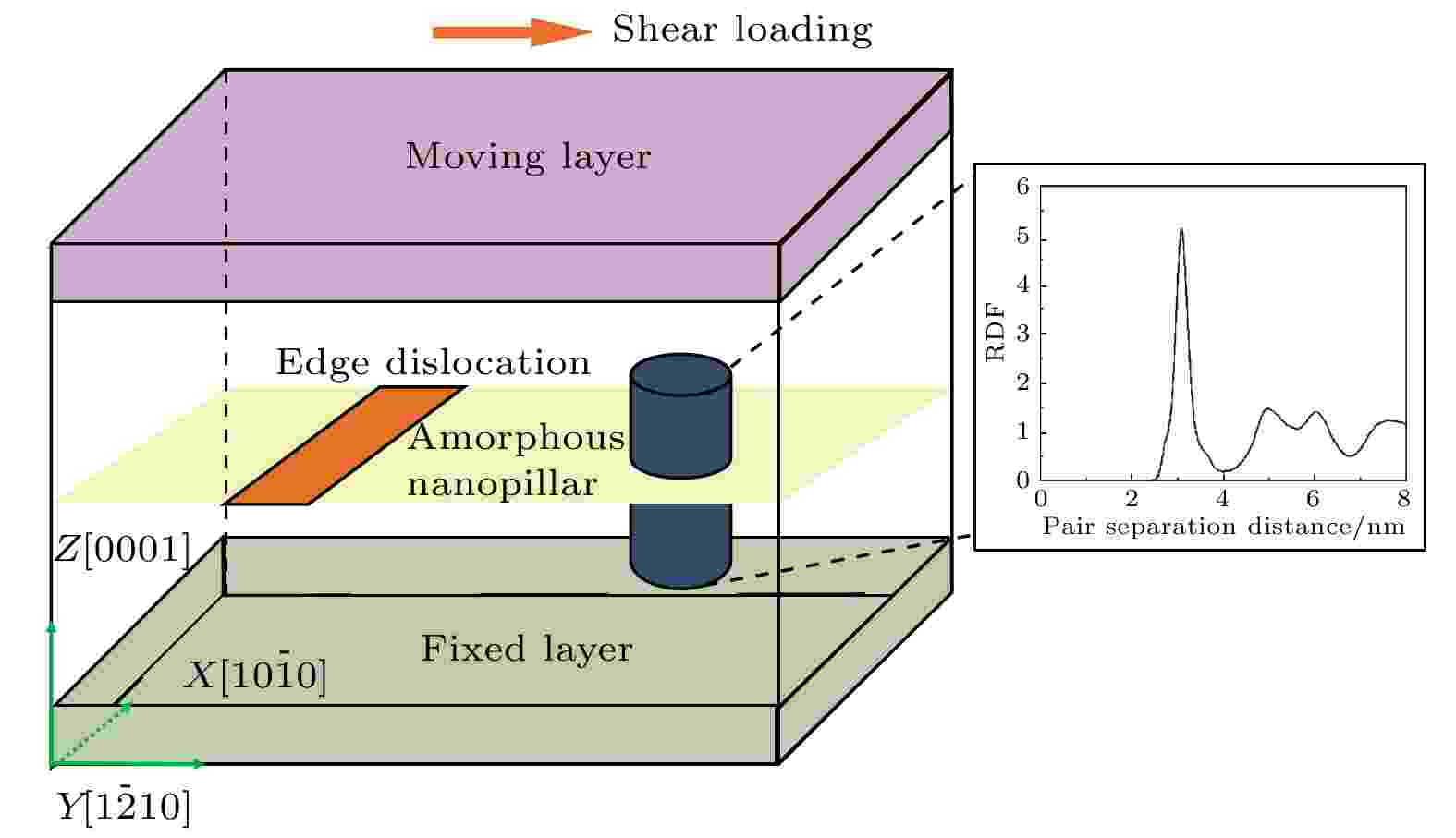
2022, 71 (14): 143101.
doi: 10.7498/aps.71.20212318
Abstract +
As the lightest metal structural material, magnesium alloy is known as the “green engineering material” of the 21st century. Especially, crystalline-amorphous dual-phase nanostructure magnesium materials exhibit excellent mechanical properties, though the mechanism of interaction between the dislocation in crystal and amorphous phase is still under the investigation. In the present work, the interaction between the edge dislocation and amorphous phase in nanocrystalline magnesium under shear load is studied by using molecular dynamics simulation. The result indicates that the interaction mechanism between amorphous phase and dislocation shows the size dependence. Compared with the sample with smaller amorphous size, larger amorphous size will lead to a large second strengthening effect. And the mechanism of the interaction between amorphous phase and dislocation is mainly attributed to the pinning effect of amorphous on the dislocation. For the samples with small amorphous size, the pinning effect of amorphous on the dislocation is limited and the pinning time is shorter. The interaction mechanism is contributed mainly by the dislocation bypassing amorphous phase. While for the samples with larger amorphous size, the pinning effect of amorphous on the dislocation is larger and the pinning time is longer. The interaction is due mainly to the cross slip mechanism of dislocation caused by amorphous phase. The results from this work have a certain reference value and guiding significance for designing and preparing the high-performance magnesium and its alloys.
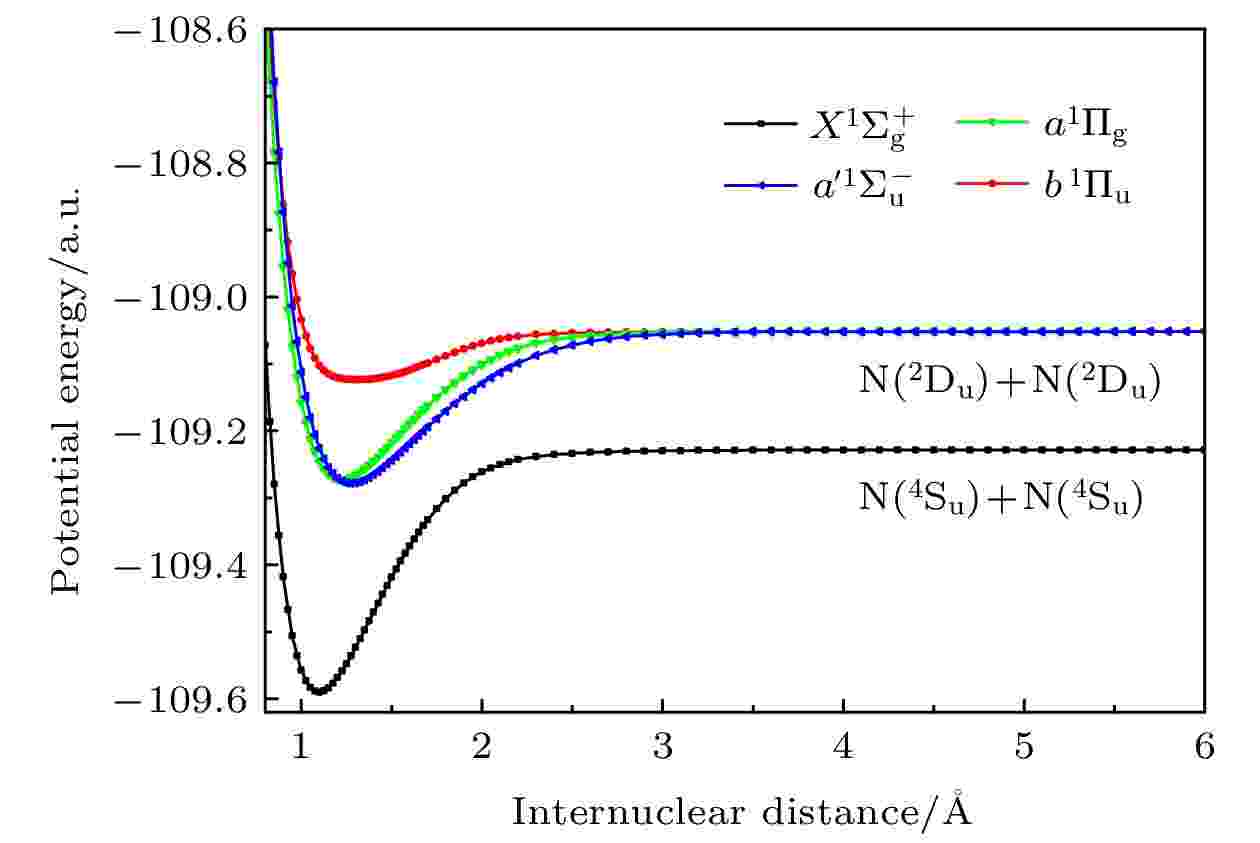
2022, 71 (14): 143102.
doi: 10.7498/aps.71.20220043
Abstract +
Multi-reference configuration interaction (MRCI) approach with Davison size-extensivity correction (+Q) is employed to calculate the potential curves and dipole moments of ${X^1}\Sigma _{\rm{g}}^ + ,{a^\prime }^1\Sigma _{\rm{u}}^ - ,{a^1}{\Pi _{\rm{g}}}$ and $b{}^1{\Pi _{\rm u}}$ electronic states of N2. The spectroscopic constants and vibrational level spaceings are calculated and in excellent agreement with the available theoretical results and experimental data. Based on the calculated molecular structure parameters, the opacities of N2 in a temperature range of 295–20000 K under a pressure of 100 atm (1 atm = 1.01×105 Pa) are presented. The results demonstrate that the wavelength range of absorption cross sections are enlarged with the temperature increasing. Moreover, the cross sections are mainly dominated in the range of ultraviolet for the cases with temperature T < 5000 K, while the obvious population can be found in the infrared ranges for the cases with temperature T > 10000 K due to the contribution of the excited states. The influence of temperature on the opacities of nitrogen molecule are investigated in the present work, which can provide theoretical and data support for researches of astrophysics and nuclear weapons.

2022, 71 (14): 143201.
doi: 10.7498/aps.71.20220341
Abstract +
The interaction of extreme ultraviolet (XUV) photon with matter is a meaningful way to understand the electronic structure of microscopic particles. In this paper, the electron angular distributions of single ionization and double ionization of Ne and Xe atoms interacting with XUV photons are investigated by utilizing a reaction microscope. The β-asymmetric parameters of 2p electrons of Ne atom, and 5p, 5s electrons of Xe atom combined with the reported experimental data are compared with those from different theoretical models. The result shows that the electron correlation effect can be ignored in the ionization of 2p electron of Ne atom. While the ionization of 5p electron of Xe atom is strongly influenced by the electron correlation effect, but not by the relativistic effect. These two effects play an important role in ionizing the 5s shell of Xe atom. In addition, this study finds that both direct double ionization and indirect double ionization exist simultaneously during the ionization of Xe atom, and gives the photoelectron angular distributions and the β-asymmetric parameters of the first step and the second step of indirect double ionization.
ELECTROMAGNETISM, OPTICS, ACOUSTICS, HEAT TRANSFER, CLASSICAL MECHANICS, AND FLUID DYNAMICS
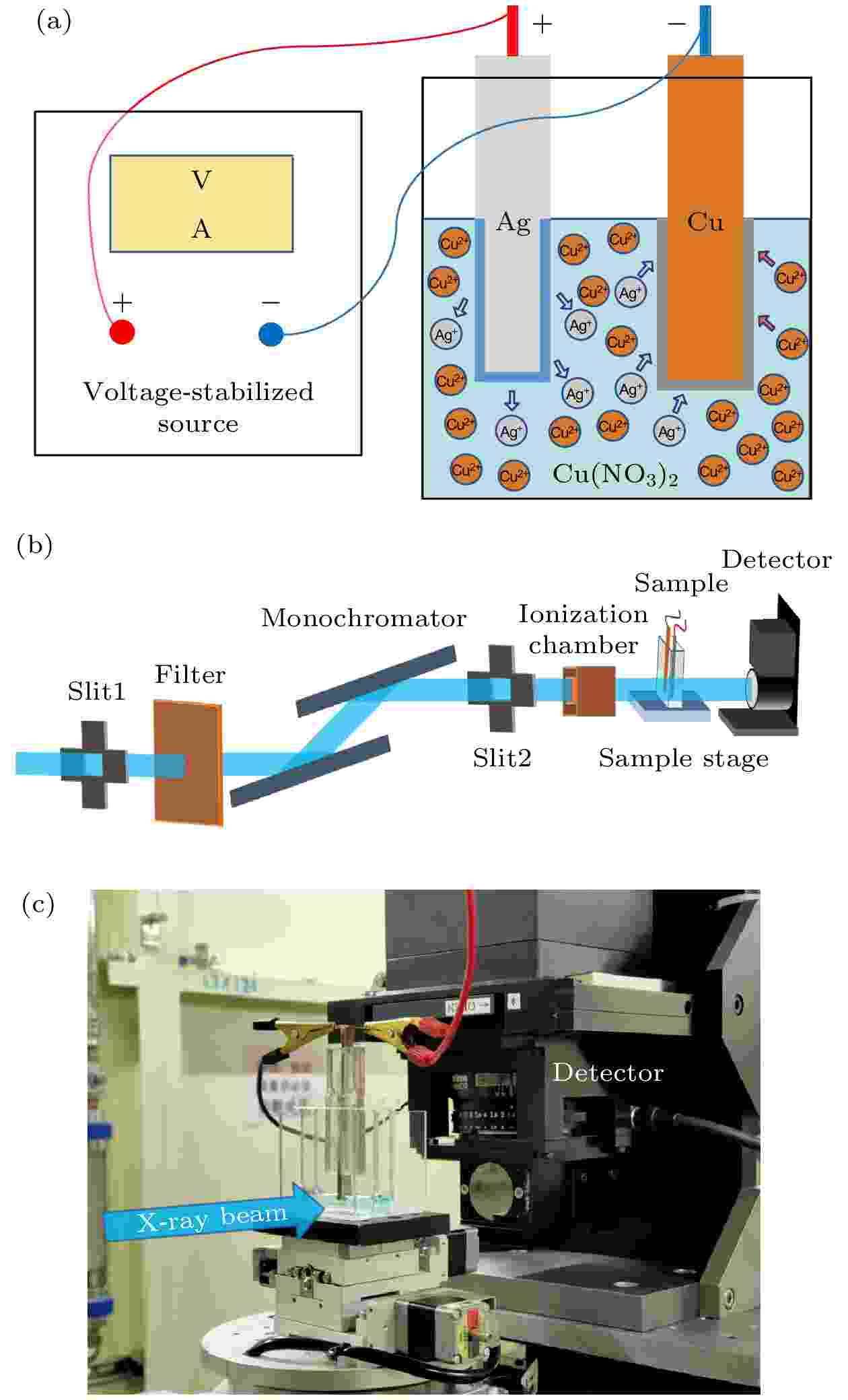
2022, 71 (14): 144101.
doi: 10.7498/aps.71.20220339
Abstract +
The in-situ dynamic observation of ion migration and redox reactions during electrochemical reactions is critical for the understanding of the charging and discharging performance, ion migration characteristics, causes and preventives of defects in cells and electrolytic cells. For the convenience of parameter tuning, an electrolytic cell is adopted to investigate the electrochemical reaction. The processes of ion migration and redox reaction are investigated based on move contrast X-ray imaging. The experimental results demonstrate that the contrast-to-noise ratio of move contrast X-ray imaging is one order higher than that of the conventional temporal subtraction imaging. The initial status of the electrochemical reaction is successfully revealed by move contrast X-ray imaging. The images show that at the very beginning of the reaction, the signals of move contrast distribute almost evenly in the electrolytic cell, which implicates that the ion migration is initiated as soon as the cell is switched on and redox reaction occurs simultaneously all over the cell, other than the fact that ions are driven by electric field, approach to the cathode and then are reduced through electron gain. The signals of move contrast imaging are obviously stronger at positions inside the shadow of the electrodes than elsewhere. This means that the redox processes react densely at the electrodes. When the electrical voltage is adjusted to a critical value and the conventional methods are hard to observe ion migration or atom accumulation, the move contrast X-ray imaging can still disclose evidently the trace of ion migration or movement of atom clusters. Therefore, the move contrast X-ray imaging can improve significantly the sensitivity of observation to the trace of ions or atoms in the electrolyte and has great potentials in in-situ investigating the characteristics of electrochemical reactions.
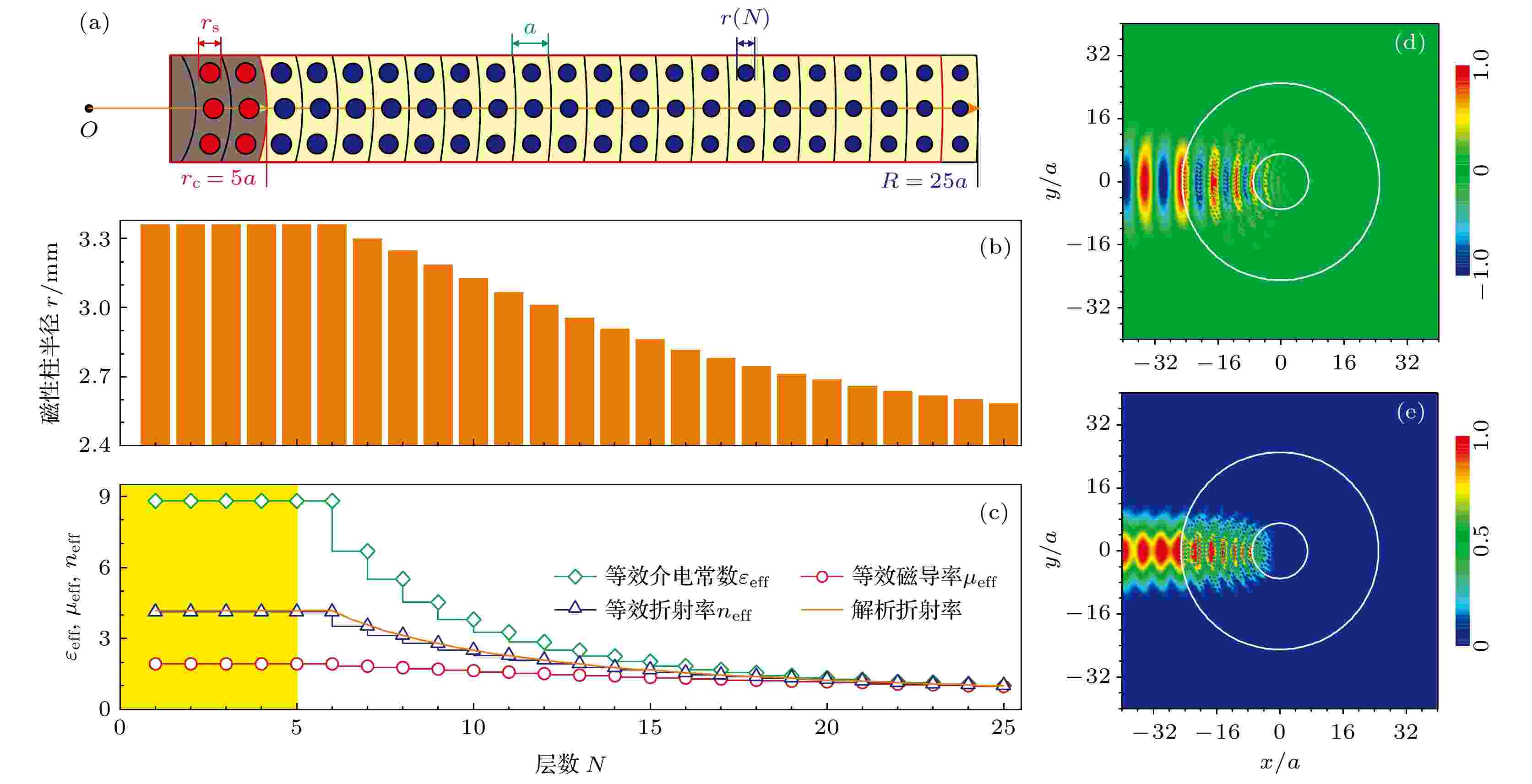
EDITOR'S SUGGESTION
2022, 71 (14): 144201.
doi: 10.7498/aps.71.20212247
Abstract +
In this work, a cylindrically symmetric gradient-refractivity two-dimensional electromagnetic system is constructed by using the magnetic metamaterials consisting of an array of ferrite rods. With the change of the bias magnetic field, the different gradient-refractivity systems can be obtained, based on which a tunable flexible beam is demonstrated. Based on the effective-medium theory, the effective electric permittivity and the effective magnetic permeability can be retrieved and thus the effective refractive index is obtained straightforwardly. It is shown that with the variation of the ferrite rod radius, an effective refractivity profile with particular gradient can be realized, which exhibits the electromagnetic “black-hole-like” effect. Especially, the gradient refractivity profile is also designed by introducing the gradient bias magnetic field, which, in principle, results in the refractivity profile with many different gradients. Finally, the propagation of a Gaussian beam in the gradient-refractivity system is simulated by using the multiple scattering theory. A few different phenomena are observed such as the “black-hole” effect, the interior beam deflection, the exterior beam deflection, and the beam splitting. Furthermore, the functionalities can be switched between each other by controlling the bias magnetic field and adding an additional degree of freedom for beam propagation.

2022, 71 (14): 144202.
doi: 10.7498/aps.71.20220332
Abstract +
The image enhancement method based on dark channel priori defogging performs well in target detection, but it takes the light intensity information as the carrier and the single optical dimension leads the target characterization efficiency to decline. Based on the sensitivity of polarization to physical properties, in this paper a proposal is made that polarization information is introduced into the traditional dark channel priori defogging method to enhance the recognition degree between different objects. The theory of backscattering and polarization detection in dark channel priori defogging method is studied, and the mechanical polarization filtering imaging equipment is built to verify the target characterization function of the proposed method in foggy environment. The research shows that the dark channel priori defogging method based on polarization can obtain the light intensity and polarization information of the object at the same time. Compared with the traditional dark channel priori defogging method, using the polarization difference between the target and the background can significantly improve their contrast. This research result can be applied to the existing polarization imaging instrument system to realize real-time backscattering and polarization information extraction, and further improve the efficiency of target detection and characterization in fog.

EDITOR'S SUGGESTION
2022, 71 (14): 144203.
doi: 10.7498/aps.71.20220147
Abstract +
Electro-optic-modulator (EOM) based Mach-Zehnder (M-Z) interferometer is a novel method of controlling the carrier envelope offset frequency (f0). It is achieved by adjusting the envelop of the pulse, while keeping the carrier frequency unchanged. In this paper, the polarization control device involved in this method is simulated, and the influences caused by the deviation of the optical axis of the wave plate on the polarization direction and the degree of output laser are analyzed. An optical axis calibration method is proposed to reduce the influence caused by the deviation of optical axis of wave plate. The effects of pump current and EOM based M-Z interferometer on f0 and the beat note (fb) between the comb and the laser are compared with each other. The experimental results show that the effect of changing the pump current on fb is 7 MHz, when the f0 adjustment quantity is 9 MHz. Under the same f0 adjustment quantity, the influence of EOM based M-Z interferometer on fb is 0.2 MHz, which is only 1/35 of the influence of pump current. Therefore, it is verified that EOM based M-Z interferometer can effectively reduce the interference to fb. It provides a technical means to narrow the line width of optical comb by using fb to lock repetition rate (fr) .
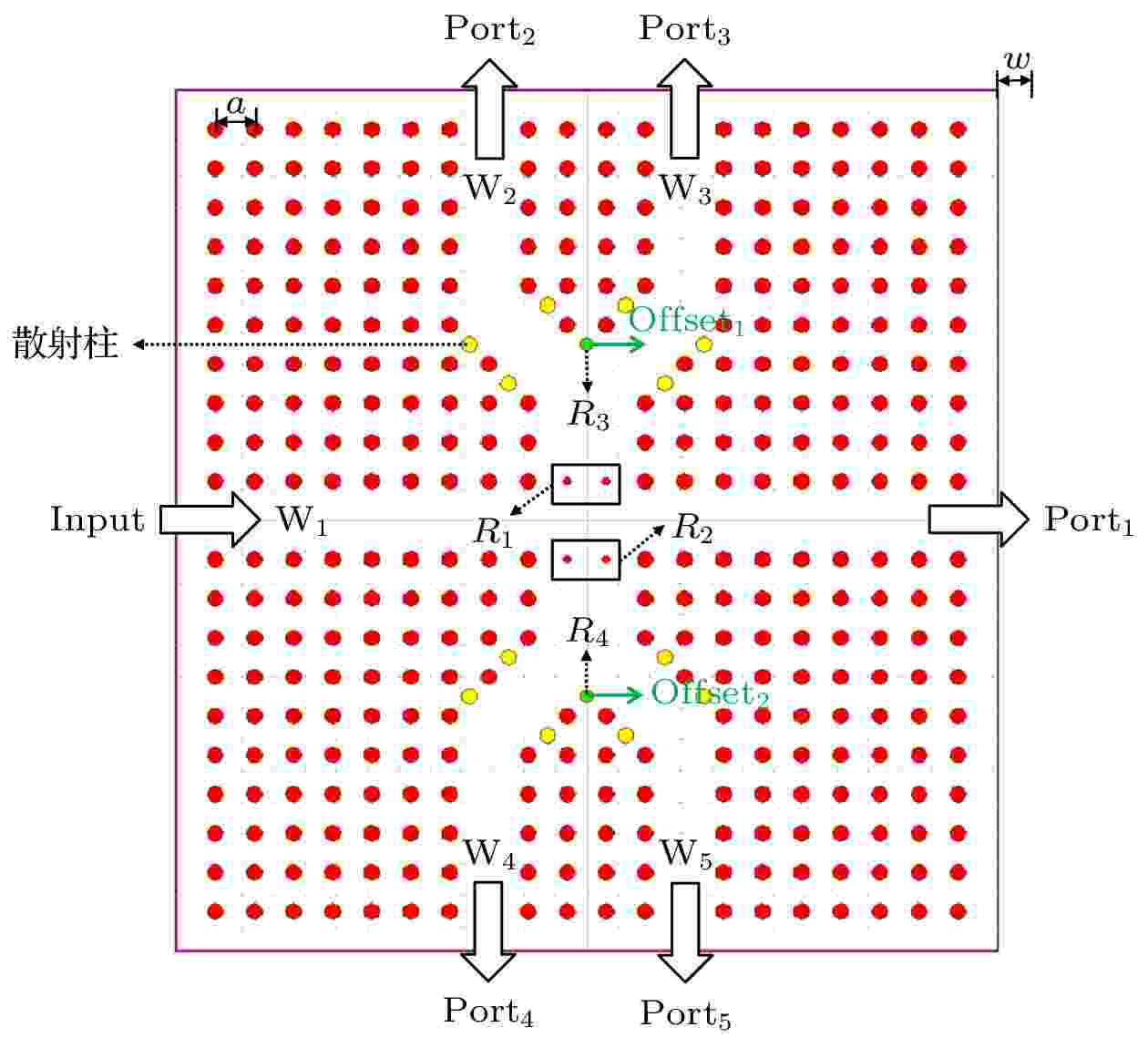
2022, 71 (14): 144204.
doi: 10.7498/aps.71.20220328
Abstract +
Beam splitter, whose main function is to achieve the splitting, combining and routing of optical signals, is an important component of photonic integrated circuits, passive optical network and other fields. Compared with the conventional beam splitter, photonic crystal beam splitter, which has the virtues of smaller size and higher transmission efficiency, is very suitable for high-density and large-scale integration. The traditional control variable method often used in the optimal design of photonic crystal beam splitter is time-consuming and inefficient. When parameter variables are large, it is difficult for beam splitter to achieve the optimal splitting performance. In addition, it is hard to realize flexible design of beam splitting ratio when optimizing multi-channel photonic crystal beam splitter by this method. In this paper, a novel photonic crystal 1×5 beam splitter, in which two special Y-junction waveguides are introduced into a completely two-dimensional square lattice silicon, is proposed and optimally designed by using downhill-simplex algorithm. Firstly, to determine the optimization range of each variable, the influences of the radius of the dielectric rod in the coupling region and the radius and the lateral offset of the regulating dielectric rod in the center of the two Y-junction waveguides on the five output ports of the 1×5 beam splitter are explored respectively by the plane wave expansion method and finite difference time domain method. The results show that the optical energy coupled from the main waveguide W1 to the upper Y-junction waveguide and lower Y-junction waveguide can be controlled by optimizing the radius of the dielectric rod in the coupling region. The transmittance of the five output ports can be controlled in proportion by optimizing the lateral offset of the regulating dielectric rods. The total transmittance of the five output ports can be improved, and the output of each port can be adjusted by optimizing the radius of the regulating dielectric rod. Then, according to the specific target of the splitting ratio, using downhill-simplex algorithm, the 1×5 beam splitter with different splitting ratio can be reversely designed by optimizing the radius of the coupling dielectric rod and the radius and the lateral offset of the regulating dielectric rod within the selected optimization range. The total transmittance of the 1×5 beam splitter is above 99%, the additional loss is less than 0.044 dB, and the response time is less than 1ps. Besides, to determine the allowable error range of each optimization variable in actual processing, the machining error of the 1×5 beam splitter is analyzed, which provides a theoretical reference for fabricating the device. Owing to the advantages of flexible splitting ratio design, high optimization efficiency, small size and excellent performance, the proposed 1×5 beam splitter will have broad application prospects in the field of photonic integrated circuits and so on.
PHYSICS OF GASES, PLASMAS, AND ELECTRIC DISCHARGES
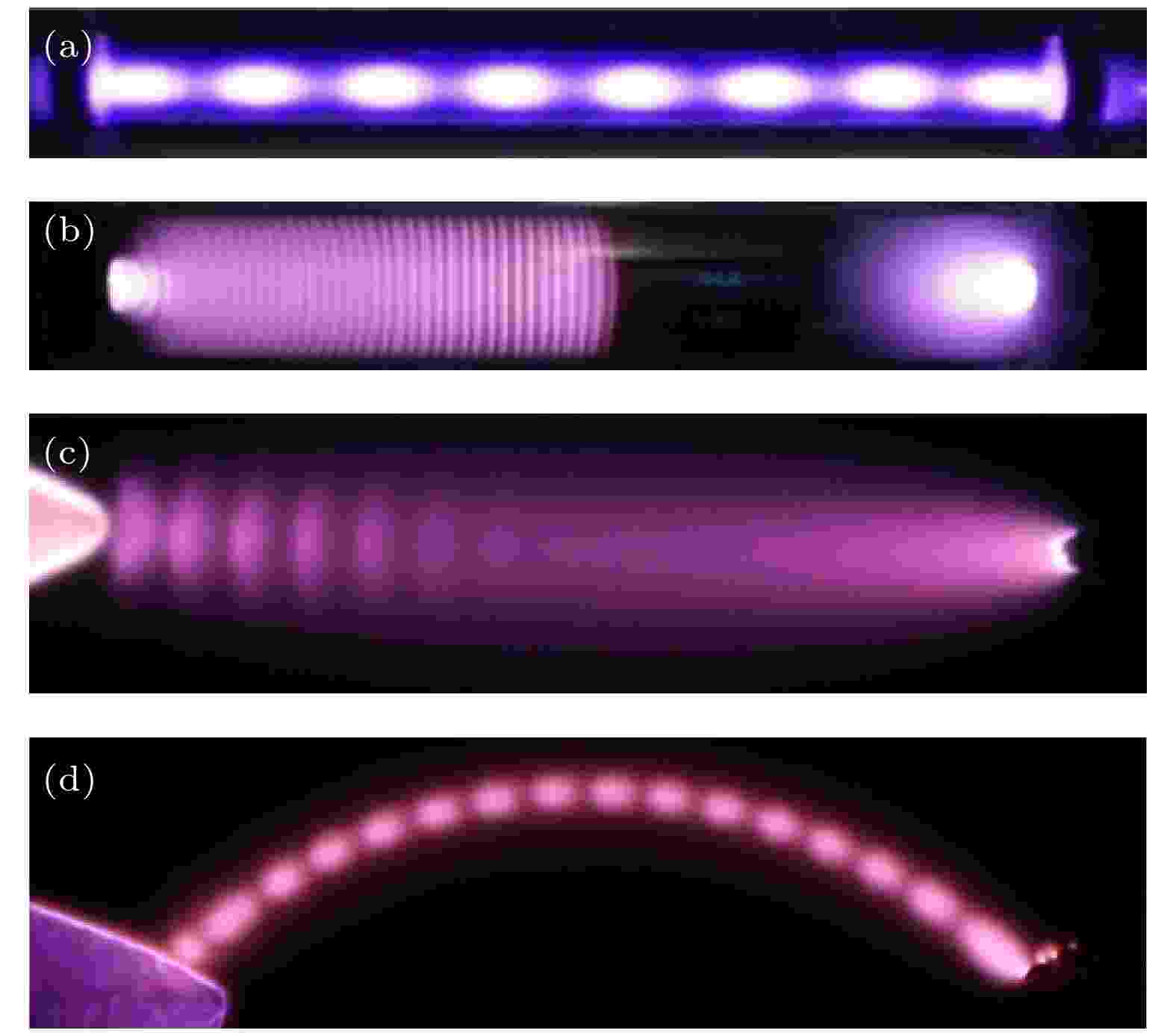
2022, 71 (14): 145201.
doi: 10.7498/aps.71.20212394
Abstract +
The self-organized striation phenomenon in the positive column region of glow discharge plasma is a basic problem in gas discharge physics, which involves rich physics such as electron dynamics, transport process, discharge instability and nonlinear phenomenon. It is an important topic in basic physics and practical application. In this work an argon glow discharge striation plasma at high pressure is reported. The electrical, optical and ionization wave propagation characteristics of the striation plasma, and the evolution of the striation plasma with pressure and impurity gas are investigated experimentally. The generation and quenching mechanism of argon striation plasma are analyzed. The results show that the striation length is about 1.5 mm, and decreases with pressure increasing, and the velocity and frequency of the ionization wave are estimated at 1.87 m/s and 1.25 kHz, respectively. The measurement of optical emission spectrum shows that the generation of striation plasma is probably related to the argon metastable atoms. The stepwise ionization process caused by metastable atoms triggers off an ionization instability. The instability propagates in the form of ionization wave, which leads the plasma parameters to be modulated longitudinally, thus, forming an alternating bright and dark striation plasma. The adding of nitrogen can effectively quench metastable argon atoms and change the electron energy distribution function, which destroys the instability conditions of the plasma, therefore, the striation plasma disappears. This work provides a new insight into the understanding of the formation and annihilation mechanism of glow discharge striation plasma at high pressure.

2022, 71 (14): 145202.
doi: 10.7498/aps.71.20212353
Abstract +
During the spacecraft from geospace penetrating into the atmosphere, a plasma sheath can be formed around its external surface due to shock heating which subsequently leads the radio communications between the space vehicle and ground-based stations to interrupt, i.e. the blackout problem happens. Many techniques have been developed to mitigate the blackout problem, and the attachment chemicals releasing is considered as an effective method. Previously, halogenides and water have been widely investigated both theoretically and experimentally. In this work, we report the mitigation of the reentry plasma sheath through releasing carbon dioxide, in which the electron density is reduced through different mechanisms and processes from the releasing halogenides. Controlled experiments are performed to investigate the carbon dioxide released in the arc wind tunnel and the high-frequency plasma wind tunnel. Results suggest that the electron density can be significantly reduced in the simulated plasma sheath environment, which provides a potential approach to solving the communication blackout problem encounterin the reentry process.

2022, 71 (14): 145203.
doi: 10.7498/aps.71.20220243
Abstract +
When intense laser pulse irradiates a target surface, the energetic processes of generation and expansion of laser-induced plasma will affect a localized pressure impulse around the irradiation zone. As a result, pulsed laser ablating granular target can drive a physical phenomenon of grain ejection. In this work, taking dry glass beads with different grain sizes as an example of granular targets and using high-speed video camera, we experimentally investigate the grain-size dependent dynamics of grain ejection driven by nanosecond laser pulses. The measured video sequences clearly exhibit that the laser-driven grain ejection process can be separated into two regimes: early-stage fast ejecting process and later-stage slow ejecting process. We find that there exists an obvious grain size effect on the kinetic energy of grains in the early-stage ejecting process. In addition, the temporal evolution of transient ejection of a curtain diameter $ D\left(t\right) $ corresponding to the later-stage ejecting process obeys the well-known “point source” law, $ {D\left(t\right)=\alpha t}^{\beta } $ , where both parameters $ \alpha $ and $ \beta $ depend on grain size. The observations mentioned above can be reasonably explained by considering the grain size dependent efficiency of impulse coupling between grain and plasma flow and plasma features generated by interaction of laser pulse with granular targets. These experimental results improve the understanding of the mechanism of laser-driven grain ejection.
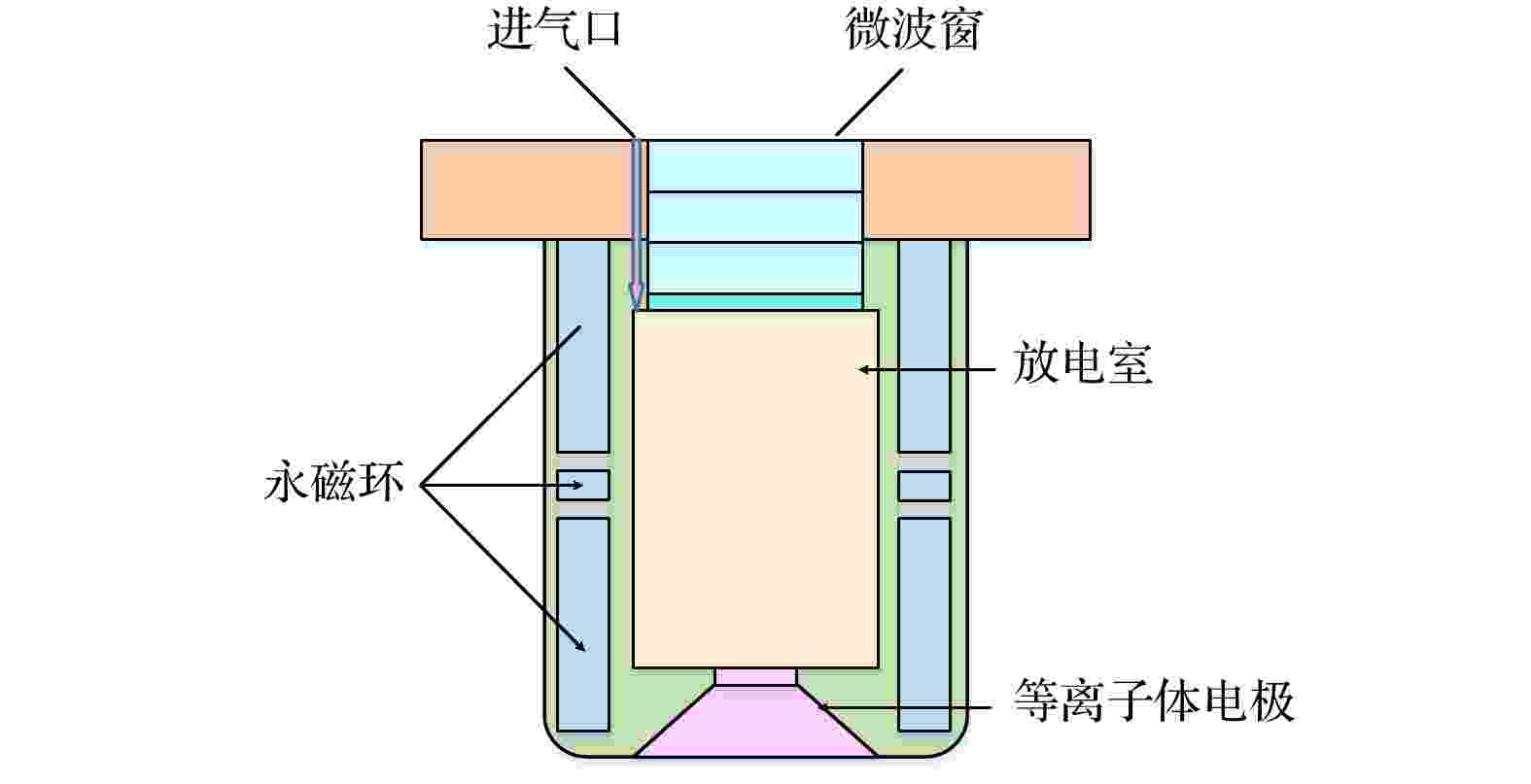
EDITOR'S SUGGESTION
2022, 71 (14): 145204.
doi: 10.7498/aps.71.20212250
Abstract +
Miniature electron cyclotron resonance (ECR) ion sources are widely used in compact ion implanters, miniature neutron tubes, and miniature ion thrusters. To understand the mechanism of miniature ECR ion source, a miniature deuterium ion source developed by Peking University is taken as the research object. In this work, a global model based on particle balance equations is developed for studying the hydrogen plasma and the deuterium plasma inside the miniature ECR source. The research results show that both the hydrogen discharge process and the deuterium discharge process of the ion source are strongly dependent on the gas pressure and microwave power. The calculated results show that high power is beneficial to increasing the proportion of H+(D+) ions, low pressure is helpful in augmenting the ratio of $ {\text{H}}_2^ + $ ($ {\text{D}}_2^ + $ ) ions, high pressure and low power are beneficial to enhancing the proportion of $ {\text{H}}_3^ + $ ($ {\text{D}}_3^ + $ ) ions. In addition, there is a large difference in ion proportion between hydrogen discharge and deuterium discharge. Under the same operating parameters, the proportion of D+ ions is 10%–25% higher than the proportion of H+ ions since the plasma density of deuterium discharge is higher than that of hydrogen plasma. Therefore, during the operation of miniature source, H2 gas, instead of D2 gas, can be used in experiment, and the proportion of D+ ions under the corresponding operating parameters can be estimated based on the proportion of H+ ions. Finally, the calculated results show that high microwave power is a prerequisite for achieving the high proportion of H+ (D+) ions. However, owing to the limitation of microwave coupling efficiency, the miniature ECR ion source cannot work when the microwave power is greater than 150 W, so that the H+ (D+) proportion cannot be further increased, thereby limiting its further applications in neutron sources, implanters, etc. Therefore, how to improve the microwave coupling efficiency has become one of the key research contents of the miniature ECR ion source. The global model proposed in this paper is helpful in understanding the physical process of the miniature ECR ion source, but there are also some shortcomings. Firstly, the effect of the secondary electron emission coefficient is not considered in the model, so it is impossible to study the influence of wall materials on ion proportion in detail. Secondly, the dissociation degree depends on the plasma measurements, and the error of plasma measurements in turn affect the accuracy of the model to a certain extent. In addition, only the hydrogen plasma model and deuterium plasma model are established in this work, based on which it is impossible to study the processes of other gas discharge plasmas. In the future, the above factors will be considered and the model will be further improved to establish a complete and self-consistent global model of the miniature ECR ion source.
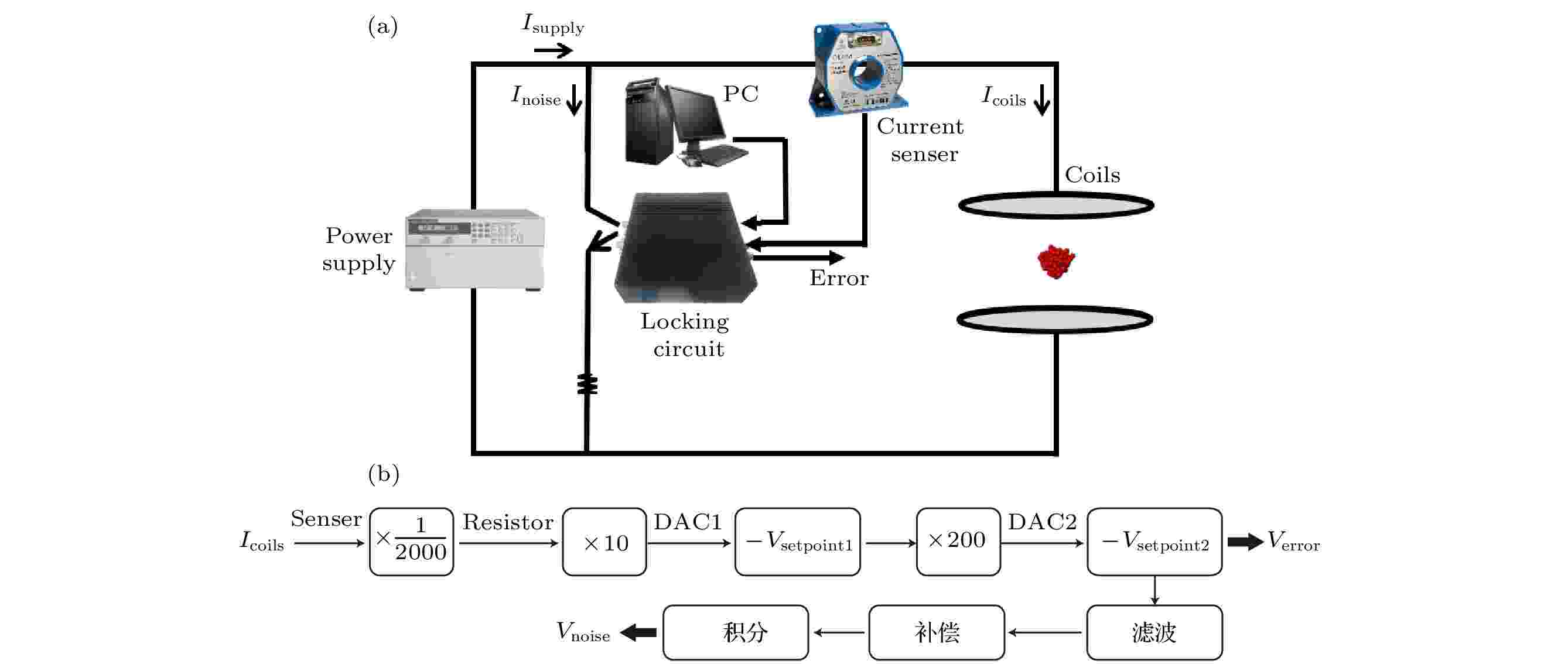
EDITOR'S SUGGESTION
2022, 71 (14): 145205.
doi: 10.7498/aps.71.20220399
Abstract +
In ultracold atomic experiments, evaporative cooling is usually achieved by using Feshbach resonance magnetic fields on the order of Gauss to hundreds of Gausses. The frequency of resonant transition induced by the optical field or radiofrequency is directly affected by the stability of the quantum axis. For example, the phase between two linearly independent vectors of a qubit is affected by the magnetic field noise. Based on the Feshbach resonance technique, magnetic field regulation has become a basic tool to control the interaction between atoms. Narrow Feshbach resonance shows unique advantages in high-temperature superconducting, superfluidity, neutron star state simulation, etc. However, since its resonance width and Fermi energy can be compared with each other, the scattering characteristics are greatly disturbed by the magnetic field. Therefore, a stable and uniform magnetic field is a prerequisite for studying the narrow Feshbach resonances. In experiment, Helmholtz coils are usually used to provide the magnetic field for cold atomic gas, and the magnetic field noise is generally determined by the coil current noise and other magnetic field noises of the environment. However, there are relatively few researches of the high-precision control of large magnetic fields above hundreds of Gausses. With a larger coil current required, the coil current noise contributes more to the magnetic field noise, thus high-precision control of large magnetic fields is still challenging. In this paper, a magnetic field locking system is used to realize a $2.27 \times 10^{-6} $ level locking of the Feshbach magnetic field. A feedback locking system is used to achieve the stability by shunting the magnetic field coil current noise. Compared with the non-locked magnetic field, the low-frequency current noise is suppressed by more than 45 dB. To assess the stability of the actual magnetic field at the atoms, the Rabi oscillation is measured, the coherence time increases nearly 9.6 times, which effectively improves the stability of the ultracold atomic system. Furthermore, we measure the atom number fluctuation at the Gaussian inflection point of the loss spectrum under different Raman pulse widths to evaluate the noise of the magnetic field. Roman pulse duration up to a 24 μs is used to increase the sensitivity of atom number fluctuation in loss spectrum relative to magnetic field noise, of which the root mean square (RMS) noise is suppressed from 20.66 mGs to 1.2 mGs, a 16-fold reduction of the noise is obtained. Such a magnetic field locking system can provide an accurate and stable background magnetic field for ultracold atomic gases, which is of great significance for extending quantum storage time, precisely controlling atomic scattering, and simulating of condensed matter and other ultracold quantum gas in experiment.
CONDENSED MATTER: STRUCTURAL, MECHANICAL, AND THERMAL PROPERTIES
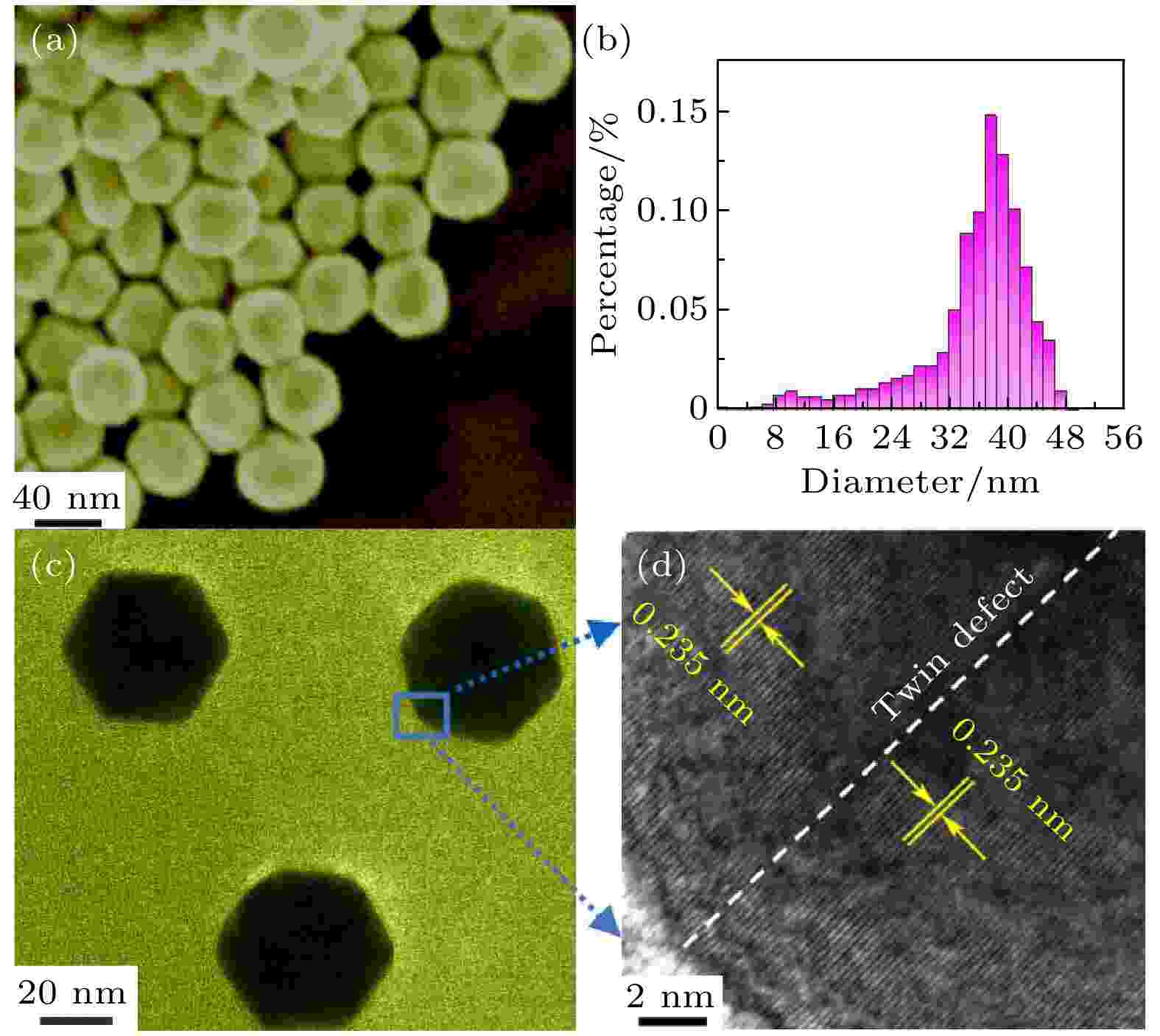
2022, 71 (14): 146101.
doi: 10.7498/aps.71.20220151
Abstract +
Creatinine is a key biomarker for diagnosing and monitoring kidney disease, so rapid and sensitive testing is very important. Raman spectroscopy is particularly suitable for quantitatively detecting the creatinine in the human environment because it is sensitive to subtle changes in the concentration of the analyte. In this work an effective strategy is provided to promote the activity of surface-enhanced Raman scattering spectroscopy by enhancing the photon-induced charge transfer efficiency at low temperature. The nano-gold icosahedron (Au20) is obtained by the seed-growing method, which is used as an active substrate for SERS. The ultra-low temperature (98 K) SERS detection technology is used to realize the rapid and sensitive detection of the dye molecule crystal violet (CV) and creatinine in normal saline. The experimental results show that at room temperature of 296 K, the detection limit of Au20 substrate for CV molecules is as low as 10–12 mol/L, and the signals are uniform; at a low temperature of 98 K, the detection limit of CV molecules can reach 10–14 mol/L, which is two orders of magnitude lower than that at 296 K. As a result, the adopted cryogenic temperature can effectively weaken the lattice thermal vibration and reduce the release of phonons, then suppress phonon-assisted non-radiative recombination. So, it will increase the number of photo-induced electrons to participate in the photo-induced charge transfer efficiency. Finally, we perform the label-free detection of creatinine in saline by using an Au20 substrate. The results show that the detection limit of the SERS substrate for creatinine is 10–6 mol/L at 296 K, and the linear correlation coefficient of the 1619 cm–1 peak is 0.9839. At a low temperature of 98 K, the detection limit of creatinine concentration is as low as 10–8 mol/L, and the linear correlation coefficient of the 1619 cm–1 peak becomes 0.9973. It can be seen that low temperature may further improve the detection limit of creatinine concentration and the linearity of characteristic peak. In summary, the current work provides a new idea for accurately detecting the creatinine concentration in the field of biomedicine.
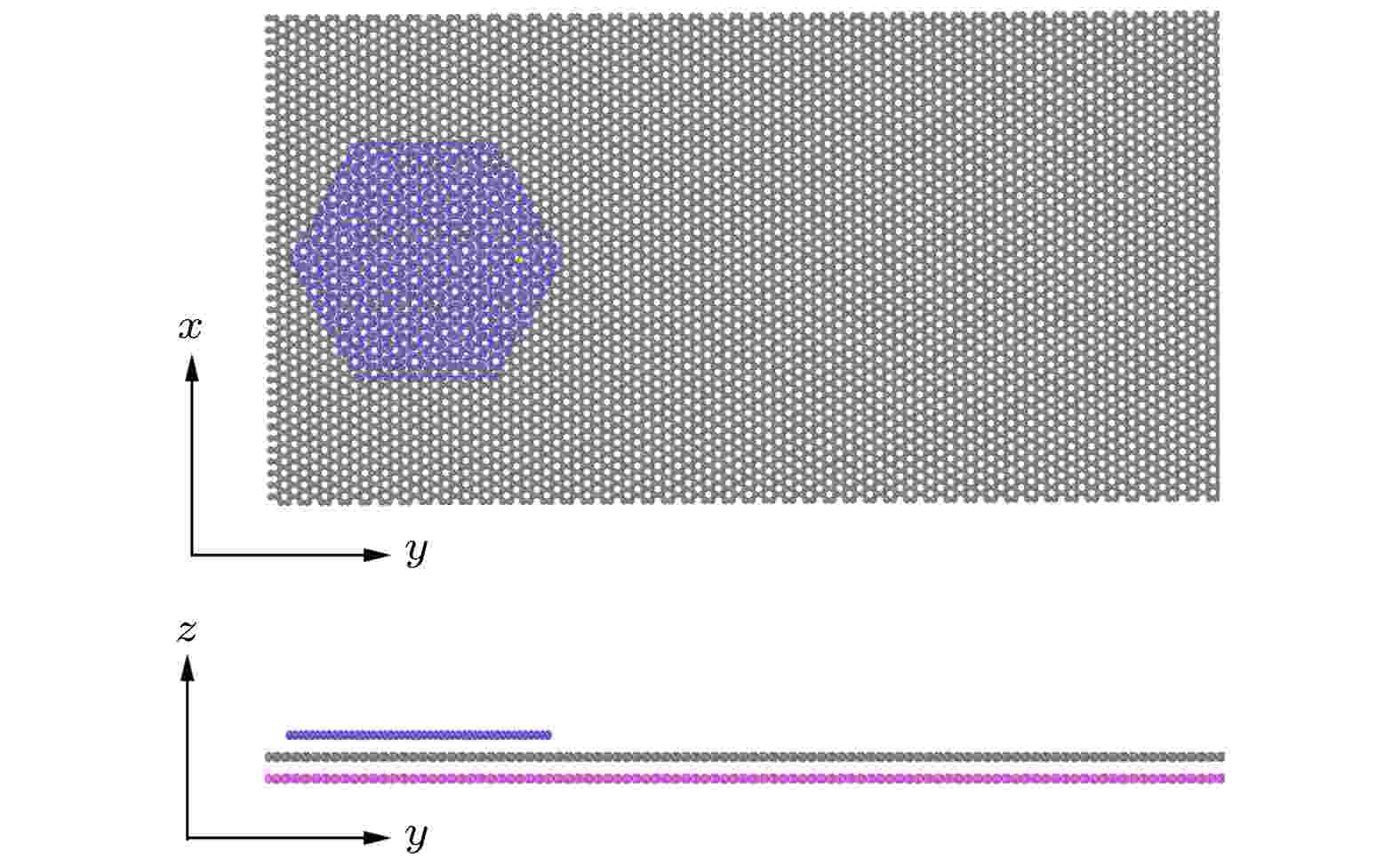
EDITOR'S SUGGESTION
2022, 71 (14): 146801.
doi: 10.7498/aps.71.20212309
Abstract +
Graphene has attracted a lot of attention due to its excellent electrical properties, however, the gapless nature of graphene limits its further applications. Doping is an effective way to open the bandgap, in which nitrogen-doped (N-doped) graphene has potential applications, but the study of its tribological properties is still lacking. In this work, the effects of nitrogen doping on the tribological properties of graphene under different interfacial structures are investigated by molecular dynamics simulation. The simulation models include a hexagonal graphene sheet, graphene or N-doped graphene substrate. The results show that the nitrogen doping has different effects on friction when interface structure is in a commensurate state and an incommensurate state. In a commensurate state, N-doping reduces the friction between interfaces in all cases, but the friction first goes up and then decreases with the increase of doping ratio of nitrogen. The local maximum value of friction occurs at a doping ratio of 7.5%. This phenomenon results from the interface structure and the change of van de Waals force between interfaces. The introduction of nitrogen atoms causes the lattice of graphene to distort, which results in the formation of local incommensurate state, thus reducing the interfacial potential barrier and friction. However, the van der Waals force between nitrogen atom and carbon atom between layers is stronger than that between carbon atoms and carbon atoms, which causes the friction to increase. When the doping ratio is low or high, lattice distortion plays more important role. The friction of N-doped graphene shows much smaller increase with load than that of ideal graphene, which indicates that the N-doped graphene possesses a better performance under high load. When the interface structure is in an incommensurate state, the introduction of nitrogen atoms shows slight influence on lattice mismatch, therefore, the change of atomic type plays a dominant role in determining the friction between interfaces, which goes up with the increase of N-doping ratio. When the substrate is graphene with vacancy defects, the value of friction between interfaces is larger than the ideal graphene substrate or N-doped graphene substrate, which indicates that the doping of nitrogen atoms has positive effect on reducing the friction of graphene with defects.
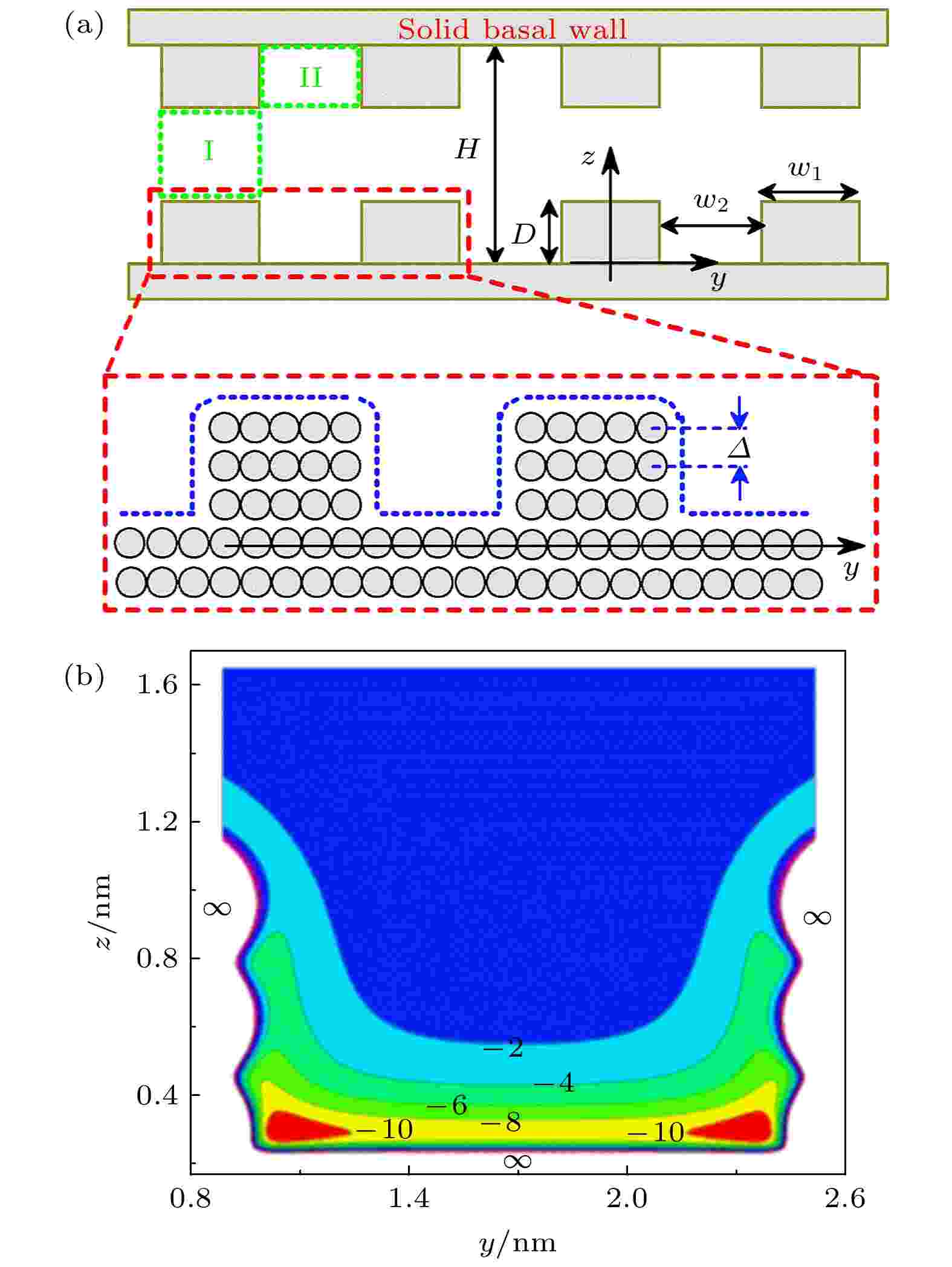
2022, 71 (14): 146802.
doi: 10.7498/aps.71.20212348
Abstract +
Henry constant and isosteric heat of adsorption are important parameters for characterizing the gas-solid interaction in an adsorption process. In order to better understand the adsorption behavior of gas in rough pores, we construct rough slit pores by using two rectangular corrugated substrates, and then calculate the potential profile in it. By utilizing classical statistical mechanics, the longitudinal Henry constant and isosteric heat of $ \text{H}_{2} $ are further calculated in the Henry region. The results suggest that both geometric morphology and pore width can significantly influence and modulate the longitudinal Henry constant and isosteric heat of the gas in the pore. Furthermore, the selectivity of adsorption in the binary $ \text{CO}_{2}/ \text{H}_{2} $ mixture is also calculated and investigated in the Henry region. In addition, the effects of corrugated substrates with different geometries on adsorption properties are also calculated and studied. The result can provide reliable theoretical basis for understanding the adsorption, separation and purification of the gas in porous materials, and it is also expected to provide helpful idea for designing and exploring new nano functional materials.
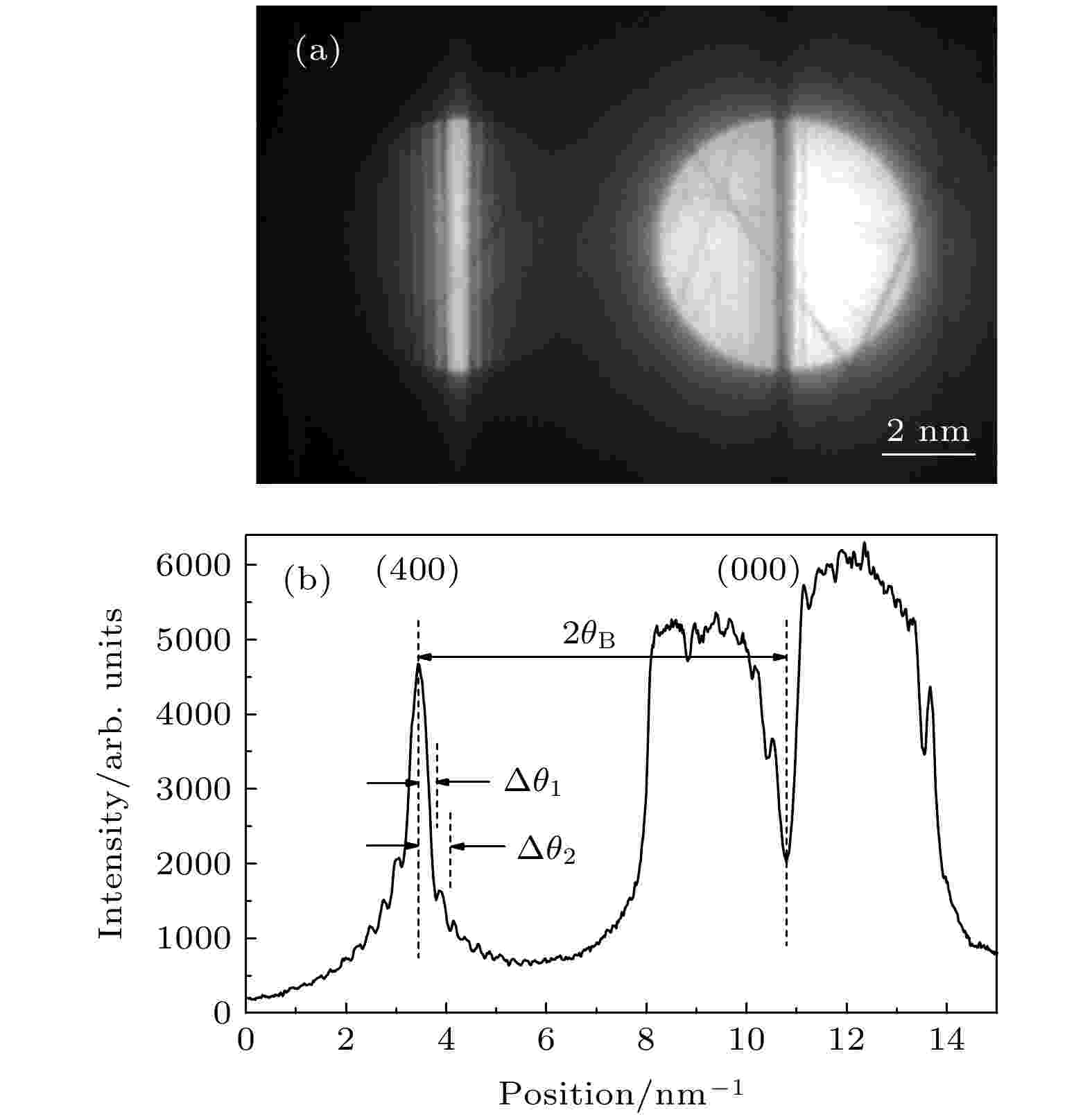
2022, 71 (14): 146803.
doi: 10.7498/aps.71.20212271
Abstract +
In this paper, the local thickness of single crystal Si film sample and the extinction distance $ {\xi }_{400} $ of the (400) plane of Si crystal are obtained by analyzing the double-beam converging beam diffraction (CBED) pattern of single crystal Si film sample under the 200 kV of accelerated voltage. The factors affecting the measurement uncertainty are analyzed, and the influence coefficients of each factor on the measurement uncertainty are discussed by using the concept of first-order partial derivative. The measurement uncertainty of thin crystal thickness and extinction distance are evaluated and expressed according to national standards GB/T 27418-2017. The conclusions are as follows. The local thickness of the measured Si crystal is estimated at 239 nm, the combined standard uncertainty is 5 nm, and the relative standard uncertainty is 2.2%. With the inclusion probability being 0.95, the coverage factor is 2.07 and the expanded uncertainty is 11 nm. With the accelerated voltage being 200 kV, the extinction distance of Si crystal (400) plane is estimated at 194 nm, the combined standard uncertainty of the extinction distance is 20 nm, and the relative standard uncertainty of the extinction distance is 10%. With the inclusion probability being 0.85, the coverage factor is 1.49 and the expanded uncertainty is 30 nm. The main factors that can affect the combined standard uncertainty of sample thickness t0 are camera constant, accelerating voltage and sample thickness, while the factors that influence the combined standard uncertainty of extinction distance are camera constant, accelerating voltage and extinction distance. The influence of the uncertainties of the measurement data of the Kossel-Möllenstedt pattern on the uncertainty of the extinction distance is ${n}_{i}{\left( {\xi }/{t}\right)}^{3}$ times that on the sample thickness, and their influence on the slope of the fitting line is about $ {n}_{i} $ times that on the intercept of the line, where $ {n}_{i} $ is a positive integer and greater than or equal to 1. If the sample is not too thin, that is, $ {n}_{i} $ is greater than 1, then the uncertainty of crystal thickness will be smaller than the uncertainty of extinction distance.
CONDENSED MATTER: ELECTRONIC STRUCTURE, ELECTRICAL, MAGNETIC, AND OPTICAL PROPERTIES

2022, 71 (14): 147101.
doi: 10.7498/aps.71.20220326
Abstract +
The transition metal dichalcogenides MX2/Chromium Trihalides CrX3 van der Waals heterostructures can control the valley polarization of of MX2 effectively, which makes them possess promising potential applications in valleytronics. In the present work, the stacking order and electronic structure of MoSe2/CrI3, MoSe2/CrBr3 and WS2/CrBr3 are investigated based on the first-principle calculation and k-projection band unfolding method. The underlying mechanism of valley splitting is also explored. The stacking energy surfaces are calculated and the stable stacking configurations are determined. The effects of the breaking of time-symmetry and spatial-symmetry on electronic structure are also revealed. Because of the orbital hybridization, the conduction band of heterostructure becomes complicated and the valence band maximum changes drastically. It is thus difficult to compare the electronic structure of vdW heterostructure with that of free-standing MX2 directly. Through the unfolding energy band, the electronic structure change of MX2 induced by CrX3 is revealed clearly, and the valley splitting of MX2 is obtained quantitatively. Moreover, the interlayer distance and strain are found to be able to tune the valley splitting effectively. When the interlayer distance reduces to 2.6 Å, the valley splitting of MoSe2/CrI3 is enhanced to 10.713 meV with the increase of AB stacking, which is 8.8 times as large as the value of equilibrium structure. This work breaks through the limit of the complex electronic structure in supercell, providing an important reference for studying other magnetic vdW heterostructure.
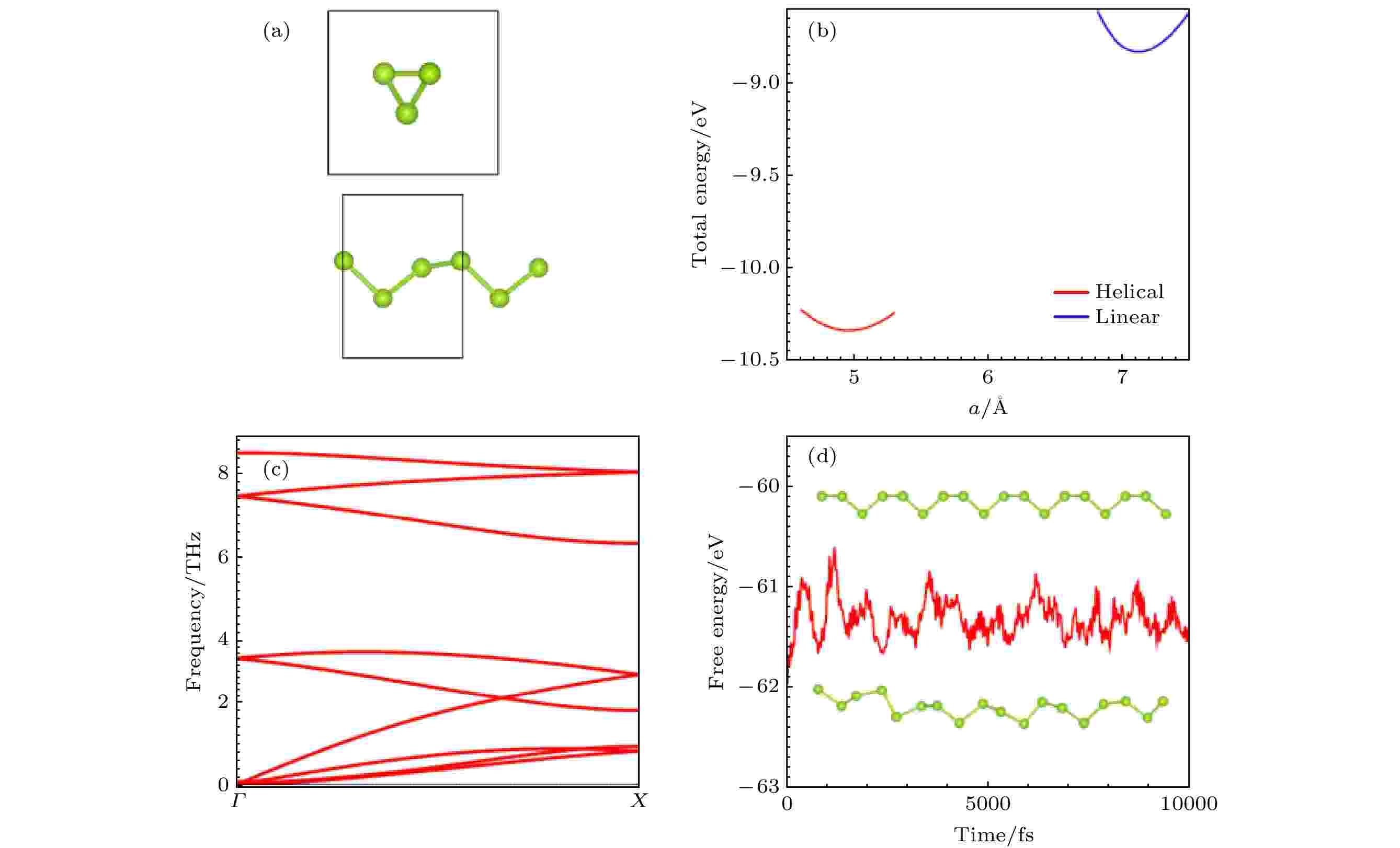
2022, 71 (14): 147102.
doi: 10.7498/aps.71.20220646
Abstract +
Tuning the electronic properties of low-dimensional materials is helpful in building nano electronic devices. Here, we investigate the structural and electronic structures of one-dimensional helical Se atomic chain by using first-principles calculations. Our results show that this structure has a much lower energy than the one with a straight-line structure. Our phonon calculations and ab initio molecular dynamics simulations suggest that this structure is both dynamically and thermally stable. The band structure shows that it is a semiconductor with a gap of about 2.0 eV and Rashba-type splitting near the X point. The helical structure is good for tuning the electronic properties by using strains. As a result, a 5% strain leads to a 20% change in the band gap while the Rashba energy offset is doubled. Moreover, we find that the valence band is a flat band, over which hole doping can induce ferromagnetism and the system becomes half-metallic. Further increasing the doping level can transform the system into a ferromagnetic metal. Such a strategy is then applied to one-dimensional helical Te atomic chain and similar results are obtained.
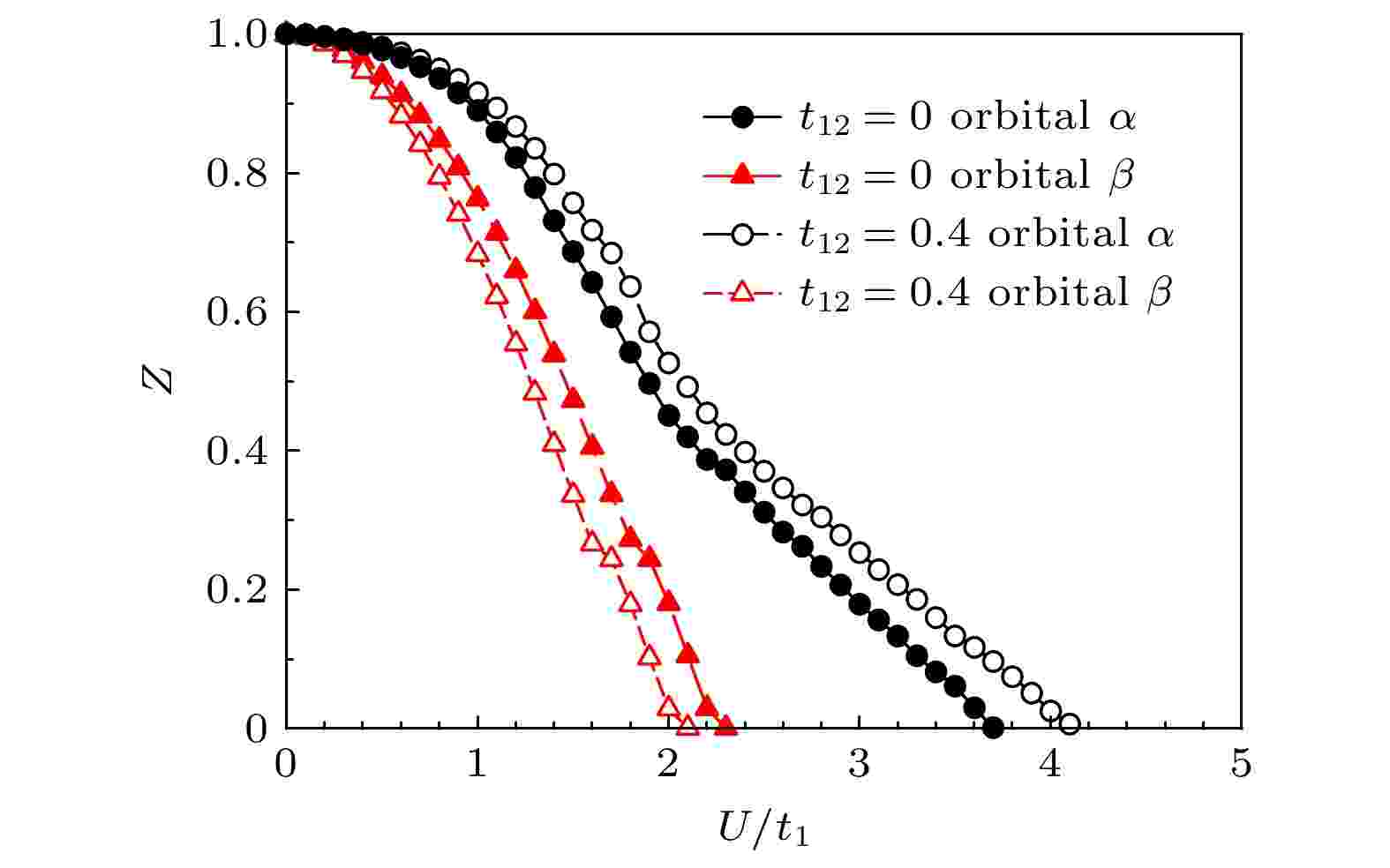
EDITOR'S SUGGESTION
2022, 71 (14): 147103.
doi: 10.7498/aps.71.20220286
Abstract +
The effect of interorbital hopping on orbital selective Mottness in a two-band correlation system is investigated by using the dynamical mean-field theory with the Lanczos method as impurity solver. The phase diagrams of the two-orbital Hubbard model with non-local interorbital hopping (t12) , where the orbital selective Mott phases (OSMP) region is expanded by the increasing of the interorbital hopping. We compare the results obtained by self-consistent relations of Bethe lattice and squate lattice based on DMFT procedure, and the general OSMP physics of Bethe lattice is consistent with that of the square lattice while the critical points of two kinds of lattices are different. We extend the method to the study of half-filled Ba2CuO4–δ materials. By comparing with the band structure obtained from the density functional theory (DFT), it is found that the isotropic inter-orbital hopping has a great influence on the bandstructure. The DFT bandstructure in DMFT is considered, and the phase diagram of the material is obtained. The half-filled Ba2CuO4–δ should be orbital-selective Mott compound according to our results.

EDITOR'S SUGGESTION
2022, 71 (14): 147201.
doi: 10.7498/aps.71.20220277
Abstract +
Topological insulator is a new quantum state of matter in which spin-orbit coupling gives rise to topologically protected gapless edge or surface states. The nondissipation transport properties of the edge or surface state make the topological device a promising candidate for ultra-low-power consumption electronics. Stanene is a type of two-dimensional topological insulator consisting of Sn atoms arranged similarly to graphene and silicene in a hexagonal structure. In this paper, the effects of various combinations of local exchange fields on the spin transport of stanene nanoribbons are studied theoretically by using the non-equilibrium Green's function method. The results show that the spin-dependent conductance, edge states, and bulk bands of stanene are significantly dependent on the direction and strength of the exchange field in different regions. Under the joint action of the exchange fields in [I: $ \pm Y $ , II: $ +Z $ , III: $ \pm Y $ ] direction, the edge states form a band-gap under the influence of the Y-direction exchange field. The band-gap width is directly proportional to the exchange field strength M, and the conductance is zero in an energy range of $ -M<E<M $ . When the exchange fields in the direction of $ +Z $ or $ -Z $ are applied, respectively, to the upper edge region and the lower edge region at the same time, the spin-up energy band and the spin-down energy band move to a high energy region in opposite directions, and strong spin splitting occurs in the edge state and bulk bands. Increasing the strength of the exchange field, the range of spin polarization of conductance spreads from the high energy region to the low energy region. When the directions of the exchange field are [I: $ \mp Z $ , II: $ \pm Y $ , III: $ \pm Z $ ], the edge states are spin degenerate, but the weak spin splitting occurs in the bulk bands. Under the condition of different exchange field strengths, the spin-dependent conductance maintains a conductance platform of $ G_\sigma=e^2/h $ in the same energy range of $ -\lambda_{\rm so} <E<\lambda_{\rm so} $ .

2022, 71 (14): 147302.
doi: 10.7498/aps.71.20220194
Abstract +
The strong coupling phenomenon between surface plasmons and quantum emitters has received extensive attention in recent years. It is usually studied by the far-field spectral detection method such as scattering, absorption, and fluorescence. In the electron energy loss spectroscopy (EELS), highly focused electron beams are used for implementing the local detection on a sub-nanometer scale, which can be more effective to study strong coupling. In this work, the electron energy loss spectrum of silver nanorods, dielectric materials and their composite core-shell nanostructures are theoretically simulated respectively, and the energy and mode characteristics of surface plasmons on the silver nanorods and the excitation characteristics of dielectric materials are obtained. The electron energy loss spectrum of surface plasmon is basically consistent with the related experimental result. Rabi splitting of spectral peaks is observed in the electron energy loss spectra of the above composite structures, and the effect of Ag nanorod size on Rabi splitting is explored. The strong coupling between the radiative dipolar and non-radiative higher-order plasmon with the excitation of the dielectric materials in the infrared and visible band is discussed, and the corresponding dispersion relation is analyzed with the coupled oscillator mode. Furthermore, the plexciton caused by strong coupling are discussed from the perspective of spatial distribution of loss spectrum imaging. Our study builds the basis for further theoretical study, and can guide the further experimental research.
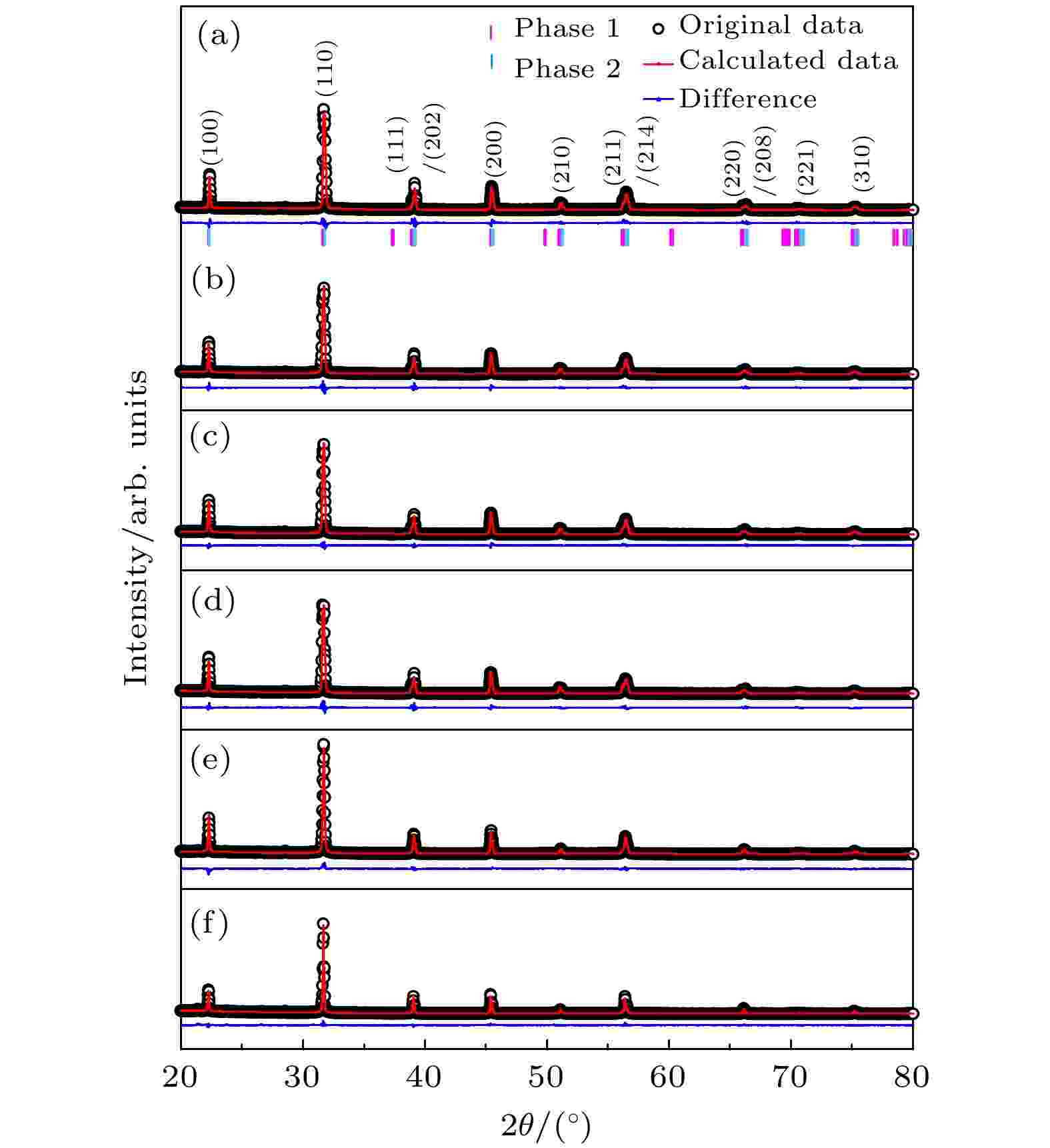
2022, 71 (14): 147701.
doi: 10.7498/aps.71.20220280
Abstract +
As a kind of ferroelectric and antiferromagnetic coexistent multi-ferroic material, BiFeO3 (BFO) has a theoretical saturation polarization over 100 μC/cm2, and a Curie temperature of 830 ℃, which may offer a huge electrocaloric effect. However, owing to the evaporation of Bi2O3 in the sintering process at high temperatures and the variation of chemical valence of iron ions, there are lots of point defects and also a large leakage current existing in BFO, making the ferroelectricity of BFO hard to develop and measure. Although the forming of solid solution with BaTiO3 (BTO) or other oxide ferroelectrics may mitigate the leakage current, high loss tangent is still existent. This work tries to address this issue by adding manganese ions into the BFO-BTO solid solution. The 0.7(BFO)-0.3(BTO)+x%MnO2 ceramics are prepared through using the conventional solid-state reaction at high temperature. The microstructure, dielectric characteristic and ferroelectric characteristic are investigated by doping different Mn4+ ions. Results indicate that the crystallographic structure is of rhombohedral and pseudocubic phase coexistence. It is observed that a certain content of Mn4+ ions may lead both the loss tangent and the leakage current for BFO-BTO ceramic to decrease, which is due to the compensation of dopant Mn4+ ions for the oxygen vacancies. In addition, the 0.7BFO-0.3BTO+0.5%MnO2 ceramic arrives at a maximum polarization of 50.53 μC/cm2 at 100 kV/cm. Finally, a direct approach is used to measure the electrocaloric effect. It is found that using the polarization flip method, the ECE temperature change is observed to increase almost 8 times when the electric field changes from 0 to –30 kV/m with respect to that when the electric field decreases from 30 kV/cm to 0. This verifies that the Lu et al’s method is also applicable to polycrystalline first-order phase transition ferroelectrics.
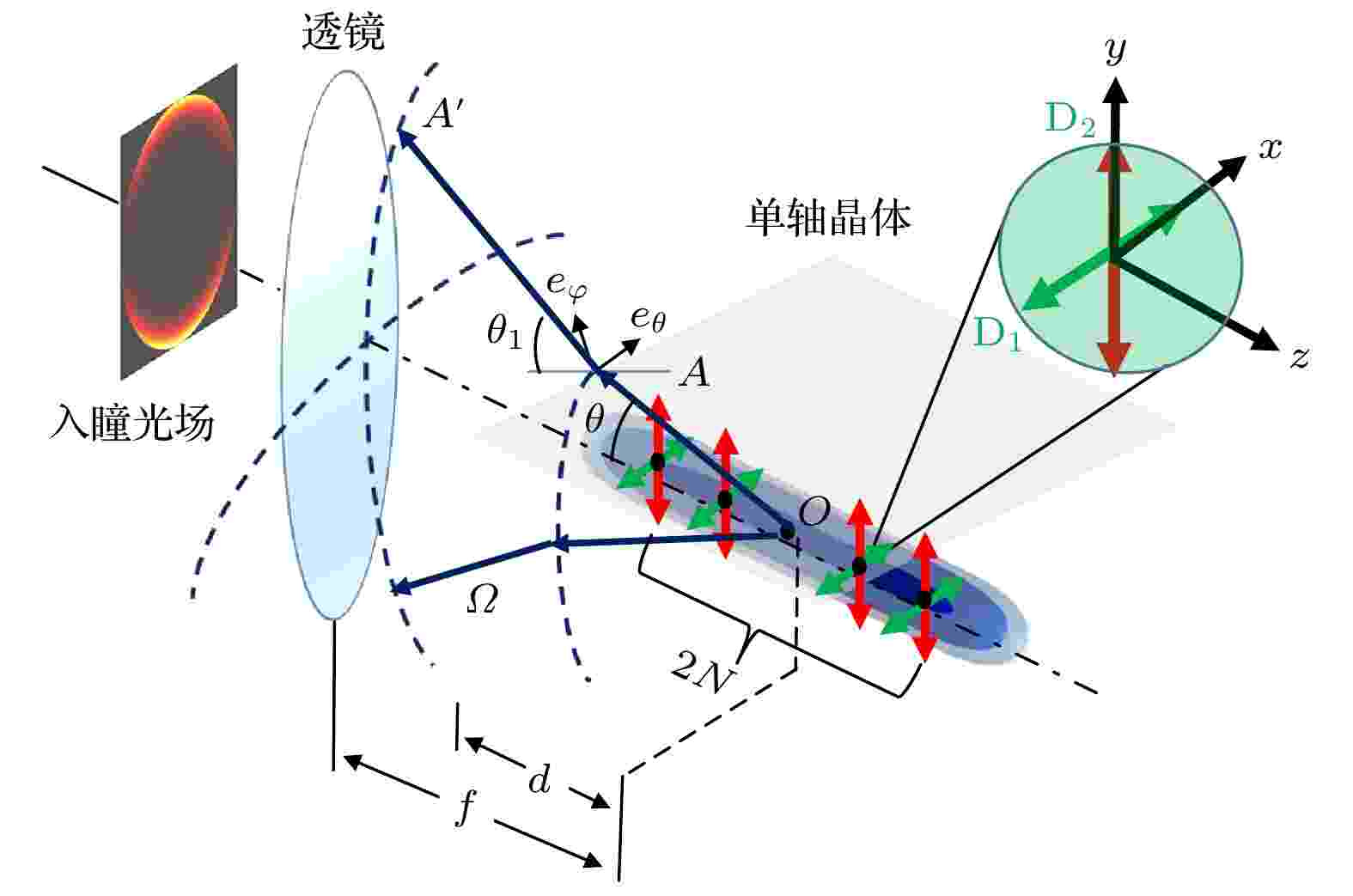
EDITOR'S SUGGESTION
2022, 71 (14): 147801.
doi: 10.7498/aps.71.20220316
Abstract +
Based on the Richard-Wolf vector diffraction theory and the inverse Faraday effect, a method of generating a high-purity longitudinal needle-shaped magnetization field in the uniaxial crystal is proposed. In this method, the inverse radiation of the electric dipole in the uniaxial crystal is used to construct an optimal entry pupil light field through regulating the multi-parameter of the number of electric dipole pairs N and their array, and then the magnetization field of the desired target is obtained by forward tightly focusing. The simulation results show that when N = 1, the focal length of the magnetic field generated in the uniaxial crystal increases by 1.4 times and the lateral resolution increases by 5% compared with the counterparts in an isotropic medium. It can be further seen that when N = 2 and N = 3, with the increase of the number of electric dipole pairs, the focal length of the needle magnetic field generated in the uniaxial crystal increases by 10%, and the lateral resolution increases by 18%. The purity of the needle magnetic field gradually increases to 1 as the magnetization field profile surface value changes from 0.1 to 1. Especially when N = 2 and the contour surface value is 0.1, the magnetic field purity is as high as 95%. The results provide a feasible scheme for generating a longitudinal magnetization field with higher purity and longer focal length in an anisotropic medium, and also present the theoretical guidance for selecting optimal pupil beams in practical applications such as all-optical magnetic recording, atom capture and lithography.




































